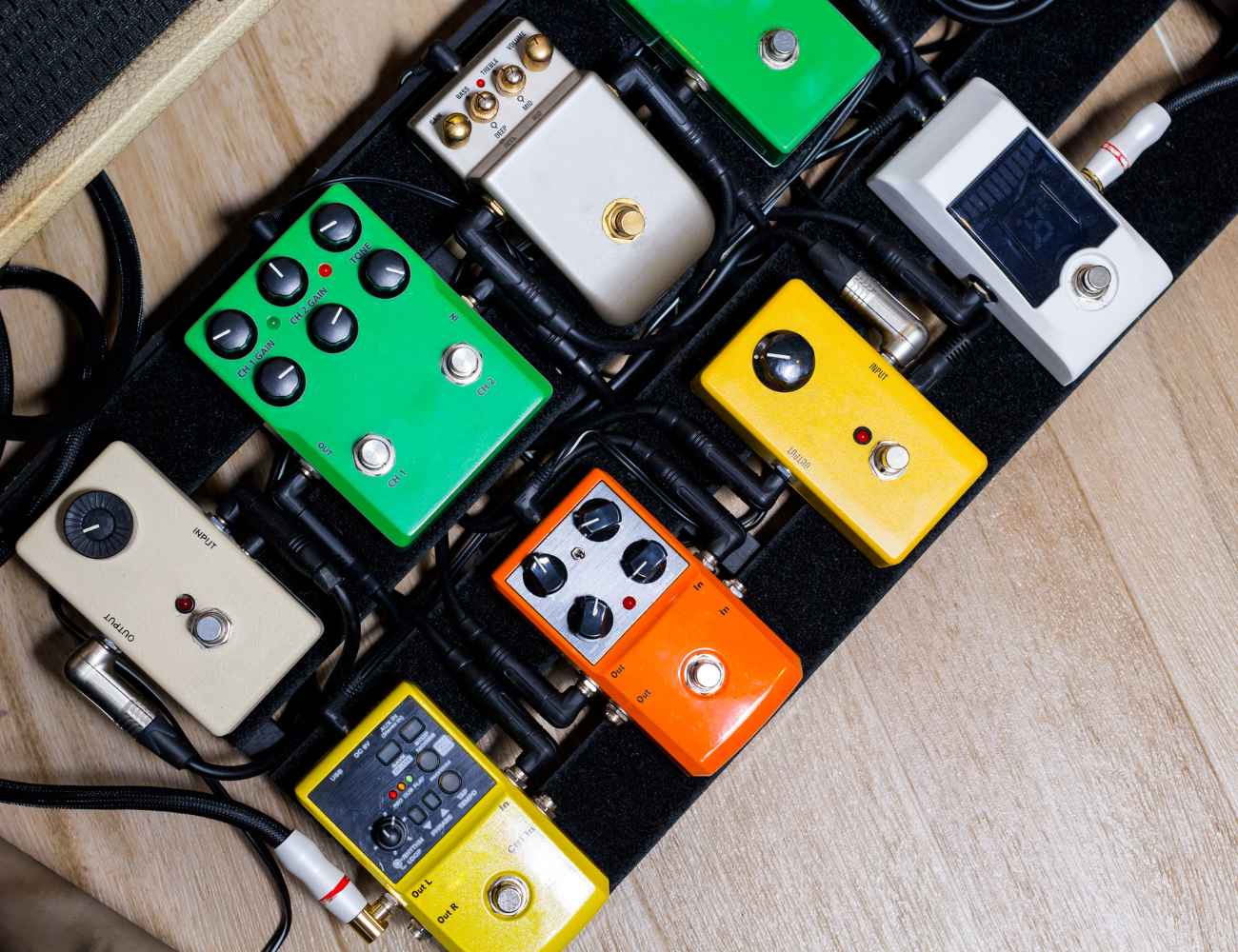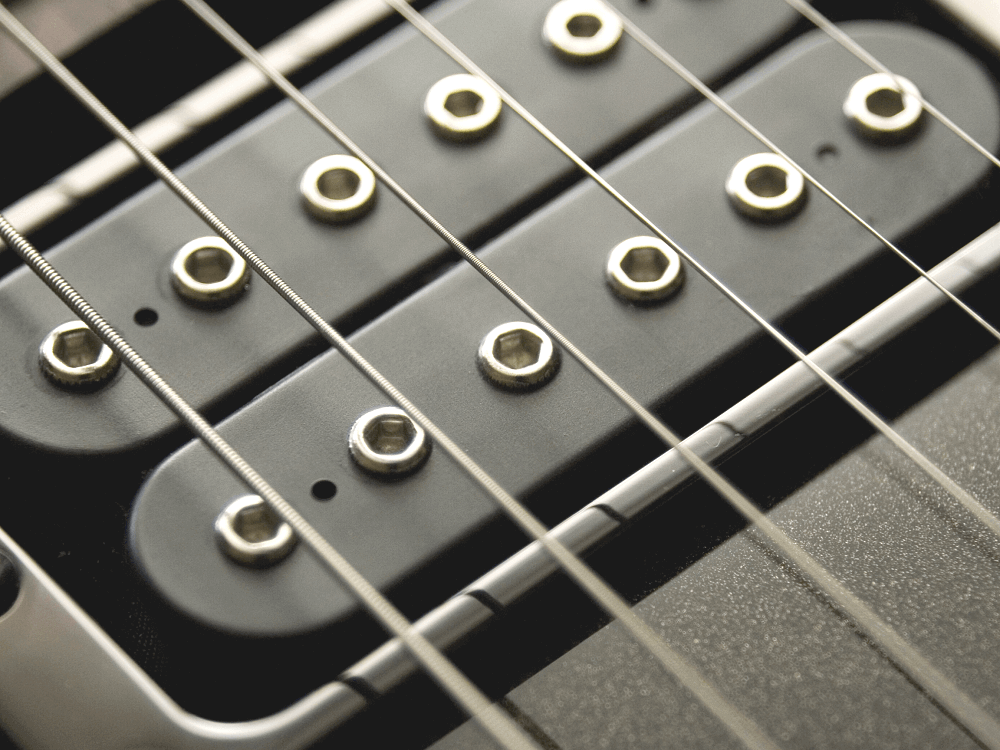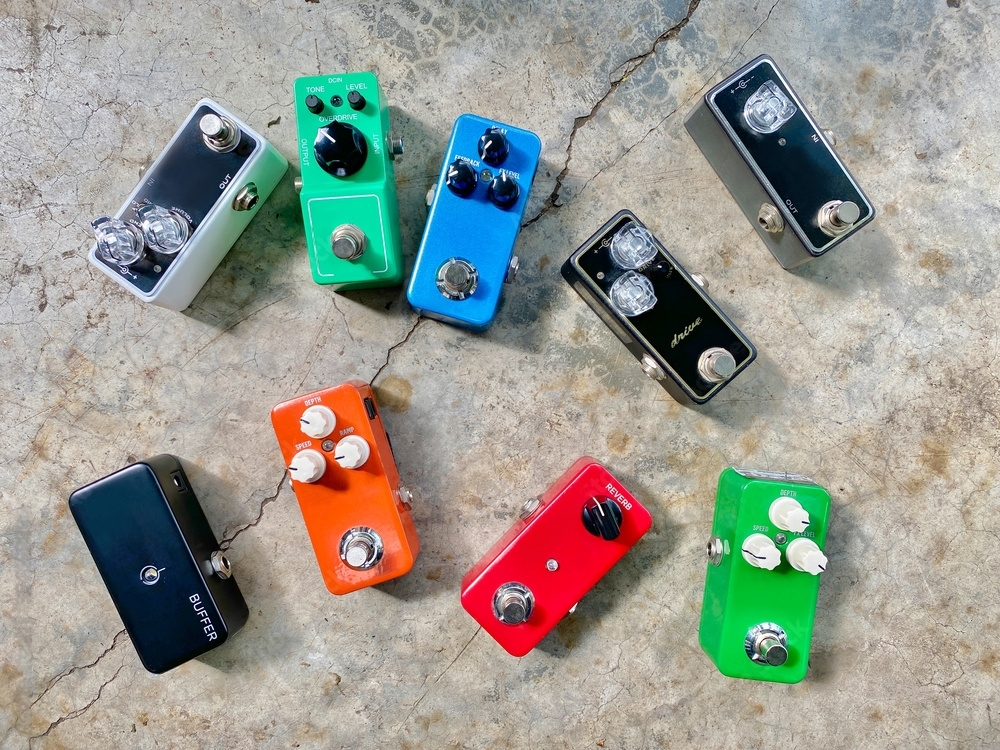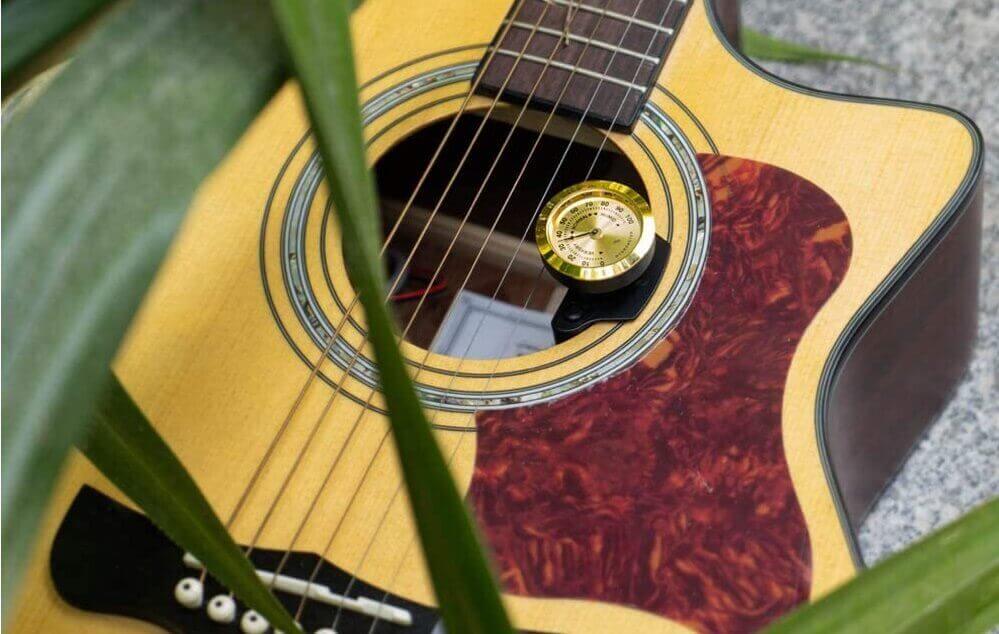Ever felt like your guitar tone needs that extra touch of magic?
Well, let’s then enter the world of chorus pedals, these little wonders can transform your sound from “meh” to mesmerizing.
Chorus pedals are the secret ingredient behind some of the most iconic guitar tones in history, and they’re perfect for adding depth, warmth, and shimmer to your playing.
In this article, we’ll dive into the fascinating realm of chorus effects, exploring why they’re essential for every guitarist’s pedalboard.
We’ll also look closely at some of the top chorus pedals, helping you find the perfect one to elevate your sound to new heights.
Table of Contents [show]
Best Chorus Pedals
Before I begin, here are my top selected choices:
Boss CE-2W Waza Craft Chorus Pedal

Legendary BOSS quality for versatile chorus effects. Check Price
|
|
Donner Chorus Pedal

Classic warm chorus tone for electric guitar and bass. Check Price
|
|
MXR Analog Chorus Pedal

Create lush, analog chorus tones with ultimate control. Check Price
|
TC Electronic CORONA CHORUS TonePrint-Enabled Chorus Pedal
TonePrint-enabled chorus pedal for endless tonal possibilities.
TC Electronic Corona Chorus offers classic and TonePrint-enabled chorus effects in a compact pedal with Speed, Depth, Level, Tone, and FX Level controls. True Bypass and stereo input/output provide flexible sound sculpting for any guitarist.
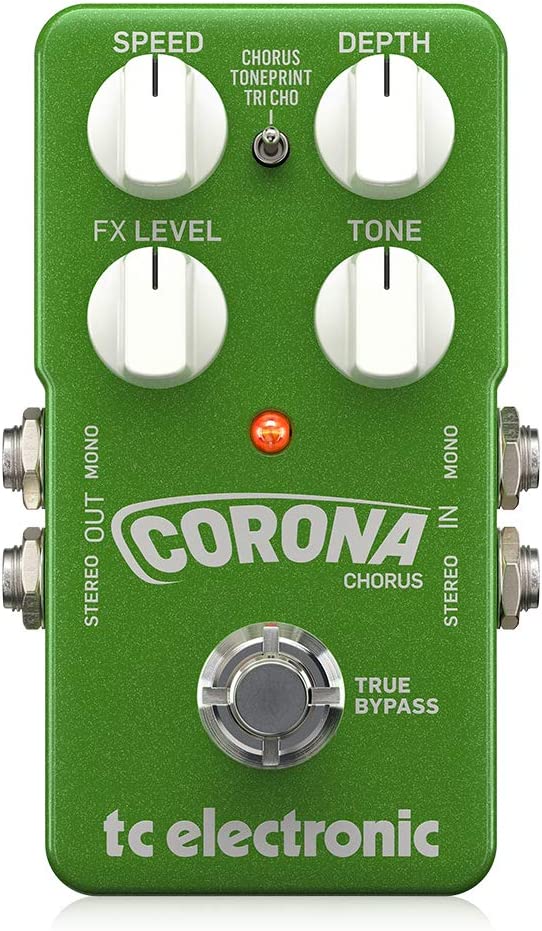
The TC Electronic CORONA CHORUS is a versatile chorus pedal designed for guitarists seeking to add depth and texture to their sound.
This compact stompbox offers many tonal possibilities thanks to its dual-mode operation.
The pedal features two distinct chorus modes: Classic and TriChorus.
While the Classic mode delivers the familiar, vintage chorus sound, the TriChorus mode provides a more decadent and spacious effect by utilizing three separate stereo chorus lines.
A vital attribute of the CORONA CHORUS is its TonePrint technology, allowing users to access custom presets created by renowned artists or design their unique chorus sounds.
In addition, guitarists can easily experiment with different settings and tailor the effect to their preferences by connecting the pedal to a computer or smartphone.
Additionally, this chorus pedal is equipped with stereo input and output, enabling the creation of immersive soundscapes when used with stereo setups.
With its actual bypass circuitry, the CORONA CHORUS ensures that your guitar’s original signal remains unaffected when the pedal is disengaged.
It’s rugged construction and intuitive interface make it a reliable and user-friendly addition to any pedalboard.
- My Review
As a guitarist, I had the opportunity to try out the TC Electronic CORONA CHORUS, and I must say that I was genuinely impressed with its performance.
From the moment I plugged in my guitar and started exploring its capabilities, the pedal delivered a variety of lush and captivating chorus effects that added depth and dimension to my playing.
I particularly appreciated the dual-mode operation, offering both Classic and TriChorus modes.
The Classic mode gave me that sought-after vintage chorus sound, reminiscent of some of my favorite bands from the ’80s, while the TriChorus mode took my sound to a whole new level with its lush, expansive stereo chorus effect.
In addition, the flexibility of these two modes allowed me to adapt the chorus effect to different genres and playing styles effortlessly.
Another standout feature of the CORONA CHORUS is the TonePrint technology.
I found it fascinating to experiment with custom artist presets and tweak the parameters to create my unique chorus sound.
Again, the ability to connect the pedal to a computer or smartphone made it incredibly convenient to access and modify these settings.
Regarding the pedal’s construction and design, I was pleased with its durability and user-friendly interface.
The knobs felt solid and offered smooth, precise control over the effect parameters.
Additionally, the true bypass feature ensured that my guitar’s natural tone remained untouched when the pedal was not in use.
However, I noticed that the pedal required a bit of a learning curve to understand and utilize all its features.
Here are the ratings I’ll give to the TC Electronic CORONA CHORUS Chorus Pedal:
As a result, it may be slightly overwhelming initially for beginners or those seeking a straightforward chorus pedal.
However, once familiar with the pedal’s capabilities, the TC Electronic CORONA CHORUS is undoubtedly an exceptional addition to any guitarist’s pedalboard.
- Pros:
- True bypass.
- Compact size.
- Versatile tone options.
- Easy to use.
- Cons:
- Somewhat expensive.
- Not suitable for all genres.
My final verdict is that the TC Electronic CORONA CHORUS Chorus Pedal is a versatile and feature-packed guitar effects pedal that offers a wide range of lush chorus sounds.
Its intuitive controls and true bypass switching make it easy to use and integrate into any pedalboard setup.
The pedal also has a sturdy construction and comes with TC Electronic’s reputation for quality and reliability.
While the price may be higher for some, the features and performance of this pedal justify the investment for serious guitar players looking for high-quality chorus effects.
I highly recommend the TC Electronic CORONA CHORUS Chorus Pedal to any guitar player searching for a top-notch chorus pedal.
Donner Chorus Pedal
Classic warm chorus tone for electric guitar and bass.
Tutti Love offers a classic chorus tone with easy controls and wide flexibilities, in a rugged aluminum alloy casing. With its carefully selected components, the analog stompbox provides smooth, warm sound perfect for guitar and bass.
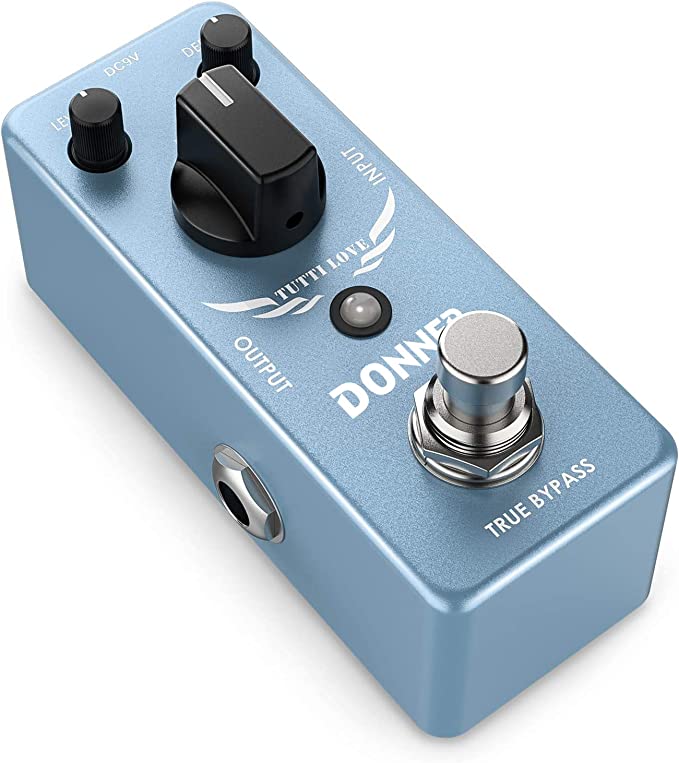
The Donner Tutti Love Chorus Pedal is an analog effect pedal designed to enhance the sound of your electric guitar or bass.
It creates a warm and classic jazz chorus tone with a natural wave curve, making it suitable for various music styles like jazz, rock, and pop.
The versatile pedal features easy in/out connectivity, an additional LEVEL knob, and the standard DEPTH and RATE parameters for better control.
Constructed with an aluminum-alloy material, this durable guitar pedal is stable and robust.
It also has a bypass function that ensures a transparent tone while the LED indicates its working state.
It’s important to note that the power supply is not included, and the pedal operates on 9V DC.
The Donner brand offers a 1-year warranty for this pedal.
This compact chorus pedal is designed with high-quality components, ensuring great sound and reliable performance.
In addition, its easy controls and flexibility make it a valuable addition to any musician’s setup.
- My Review
I recently tried the Donner Tutti Love Chorus Pedal, which genuinely impressed me.
As an analog chorus pedal, it delivers a warm and classic jazz chorus tone that adds depth and richness to my electric guitar and bass playing.
This versatile pedal caters to various music styles, including jazz, rock, and pop.
Setting it up was a breeze, thanks to its easy in/out connectivity.
I appreciated the additional LEVEL knob, which allowed me to fine-tune my sound alongside the standard DEPTH and RATE parameters.
The aluminum-alloy construction gives the pedal a solid, stable feel, and the actual bypass function ensures a transparent tone without any unwanted coloration.
While the power supply is not included, the pedal runs on a standard 9V DC, which is easy to find.
Finally, it’s worth mentioning that the LED indicator is a helpful feature, showing the pedal’s working state at a glance.
One downside I noticed is that the rubber bottom of the pedal didn’t adhere well to my adhesive Velcro, making securing it to my pedalboard slightly challenging.
However, this minor issue didn’t affect the pedal’s performance.
The Tutti Love Chorus Pedal did not disappoint in terms of sound quality.
It produced a smooth, natural chorus tone reminiscent of the sounds used by jazz, rock, and pop artists for decades.
It’s also worth noting that the pedal remained quite low-noise during my usage, which is essential for any professional setup.
Here are the ratings I’ll give to the Donner Chorus Pedal:
Despite minor drawbacks, I found the Donner Tutti Love Chorus Pedal a valuable addition to my gear.
Its versatility, ease of use, and high-quality sound make it a worthwhile investment for musicians looking to enhance their sound with a classic chorus warmth.
- Pros:
- Analog sound reproduction
- Flexible control options
- Durable aluminum-alloy casing
- True bypass for transparent tone
- Cons:
- Power supply not included
- May not be suitable for all genres
- May cause slight tone suck
My final verdict is that the Donner Chorus Pedal is a solid choice for guitar and bass players who want an affordable, durable, and versatile chorus effect.
It offers flexible control options, a true bypass for transparent tone, and a classic warm jazz chorus sound well-suited for jazz, rock, and pop genres.
While it may cause a slight tone suck and does not come with a power supply, its overall value and performance make it a worthwhile investment for beginners and professionals.
Aguilar Chorusaurus Chorus Bass Effects Pedal
Warm, rich analog chorus with adjustable blend, rate, intensity, and width.
The Chorusaurus pedal provides bassists with warm, rich analog chorusing via its intuitive four-knob layout. Blend, Rate, Intensity, and Width knobs allow for maximum tonal control, from subtle swirling textures to extreme chorusing.
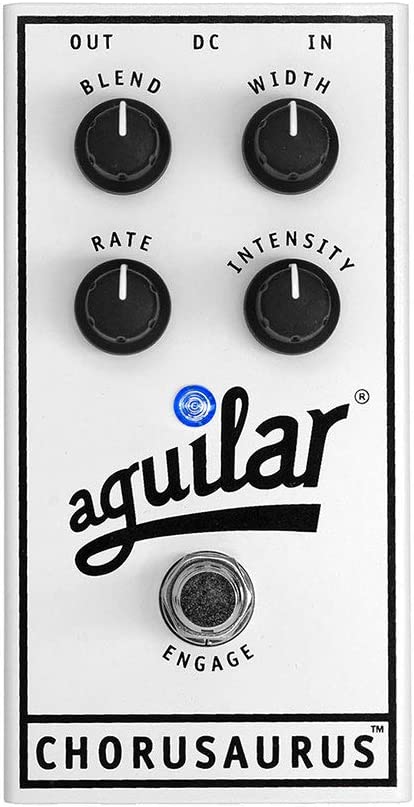
The Aguilar Chorusaurus Chorus Bass Effects Pedal is an excellent equipment for bass players looking to enhance their sound with warm, rich tones.
Utilizing analog Bucket-Brigade technology, this pedal delivers organic, lush chorusing effects.
Its compact white chassis measures 6.1 x 3.1 x 2.25 inches and weighs just 0.62 pounds, making it portable and easy to incorporate into any pedalboard setup.
You’ll find a user-friendly layout with four knobs allowing precise control over your tone.
The Blend knob lets you adjust the mix of dry and wet signals, while the Rate, Intensity, and Width knobs help you shape the chorus effect to your liking, from subtle to extreme.
In addition, this pedal is equipped with a gig-saver bypass feature, ensuring your signal continues to pass through even if the battery runs out.
Connectivity options include one 1/4″ input jack and one 1/4″ output jack, which can be used for either mono or stereo operation.
Powering the pedal is simple, as it can run on a nine-volt battery or an optional universal power supply.
- My Review
Having personally tried the Aguilar Chorusaurus Chorus Bass Effects Pedal, I must say it exceeded my expectations.
The warm, rich tone it produces is a testament to its high-quality analog Bucket-Brigade technology.
In addition, when playing with the pedal, I noticed that it adds a lush, organic chorusing effect to my bass sound, which can be both subtle and extreme, depending on my preferences.
One of my standout features is the user-friendly layout with its four knobs: Blend, Rate, Intensity, and Width.
I found dialing in the exact chorus sound I wanted incredibly easy, and the knobs were very responsive.
The Blend control, in particular, allowed me to find the perfect balance between my dry and wet signals, making it easy to incorporate the effect into my overall sound without overpowering it.
The pedal’s compact size and lightweight design made adding it a breeze to my pedalboard.
Measuring just 6.1 x 3.1 x 2.25 inches and weighing 0.62 pounds, it didn’t take up much space and was easy to transport.
The connectivity options were also satisfactory, with one 1/4″ input jack and one 1/4″ output jack allowing for mono or stereo operation.
I appreciated the gig-saver bypass feature, which ensured my signal would continue to pass through, even if the battery died during a performance.
Powering the pedal was straightforward, as it could be run on a nine-volt battery or an optional universal power supply.
However, I wish the power supply was included with the pedal, making it even more convenient for users.
Here are the ratings I’ll give to the Aguilar Chorusaurus Chorus Bass Effects Pedal:
In my experience, the Aguilar Chorusaurus Chorus Bass Effects Pedal is a fantastic addition to any bass player’s gear.
While it might be nice to have the power supply included, the pedal’s remarkable sound quality, intuitive controls, and convenient design make it a valuable investment for those seeking a special bass chorus effect.
- Pros:
- Analog Bucket-Brigade technology.
- Intuitive four-knob layout for maximum tonal sculpting.
- Gig-saver bypass allows signal to pass even if battery dies.
- Cons:
- No significant drawbacks.
My final verdict is that the Aguilar Chorusaurus Chorus Bass Effects Pedal is an excellent choice for bass players looking to add lush, organic chorusing to their sound.
With its analog Bucket-Brigade technology, intuitive four-knob layout, and gig-saver bypass, this pedal offers unparalleled control over your tone.
In addition, it ensures your signal passes even if your battery dies.
The lack of negative reviews is a testament to its quality.
While the brand and value scores are slightly lower, the overall performance, versatility, and features make it an excellent investment for any bass player looking to enhance their sound.
Boss CE-2W Waza Craft Chorus Pedal
Legendary BOSS quality for versatile chorus effects.
BOSS celebrates 40th anniversary with CE-2W chorus pedal, offering classic analog chorus sound with extra features and quality craftmanship. Stereo output, variable chorus depth and Japanese-made quality ensure a perfect addition to any guitar rig.
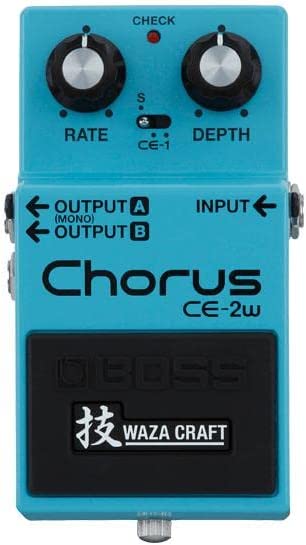
The Boss CE-2W Waza Craft Chorus Pedal is a guitar effects pedal that combines the iconic sounds of the CE-1 and CE-2 chorus pedals, providing guitarists with a versatile and high-quality chorus effect.
This blue pedal, measuring 6 x 3.8 x 2.65 inches and weighing 0.46 kilograms, offers three distinct modes: Standard, CE-1 Chorus, and CE-1 Vibrato.
These modes enable a range of sound possibilities, from the classic CE-2 chorus to the rich stereo chorus and vibrato of the legendary CE-1.
Manufactured in Japan, the CE-2W pays homage to the birthplace of the original Boss pedals.
With its simple-to-use design, the pedal features rate and depth controls, allowing users to tweak the chorus effect to their liking easily.
As part of the celebrated Waza Craft series, this pedal represents Boss’s commitment to top-notch quality in the studio and on stage.
The CE-2W is a testament to Boss’s storied history in the world of guitar effects, offering an authentic recreation of classic chorus sounds while adding new dimensions to the guitarist’s sonic palette.
- My Review
As a guitar enthusiast who has tried the Boss CE-2W Waza Craft Chorus Pedal, I can honestly say it offers a remarkable chorus effect that captures the essence of the classic CE-1 and CE-2 pedals.
With its three modes—Standard, CE-1 Chorus, and CE-1 Vibrato—this pedal delivers an impressive range of sounds, from subtle, almost imperceptible chorus to lush, full-bodied stereo chorus and vibrato.
One of the things I appreciate about the CE-2W is its simplicity.
With just two knobs for rate and depth, dialing the perfect chorus sound for any musical context is easy.
However, this pedal is highly versatile despite its simplicity, making it suitable for various genres and playing styles.
It can produce iconic 80s chorus tones, Clapton-esque sounds, and even the unique textures of artists like Mac Demarco.
While the CE-2W is a premium-priced pedal, its quality and range of sounds make it a worthwhile investment.
In addition, it’s solid construction and low-noise floor are testaments to the trusted Boss quality, ensuring it performs reliably on stage, in the studio, or at home.
One downside I experienced was the introduction of some noise or hum into my pedalboard.
However, this issue might not affect everyone and could depend on individual setups.
In my experience, the CE-2W Waza Craft Chorus Pedal is undoubtedly one of the best choruses pedals on the market.
Here are the ratings I’ll give to the Boss CE-2W Waza Craft Chorus Pedal:
It successfully pays tribute to the iconic CE-1 and CE-2 chorus pedals while simultaneously expanding their capabilities with new sound possibilities.
As a guitar player looking for that perfect chorus sound, I highly recommend the Boss CE-2W Waza Craft Chorus Pedal to fellow musicians seeking a versatile, high-quality chorus effect.
- Pros:
- Authentic classic chorus sound
- Three modes for added variety
- Low noise floor
- Well-built and durable
- Cons:
- Relatively expensive
- May introduce noise/hum into pedalboard
My final verdict is that the Boss CE-2W Waza Craft Chorus Pedal is an excellent choice for guitarists looking for an authentic classic chorus sound.
It offers three modes for added versatility and has simple controls, making it easy to use.
The pedal is well-built and durable, typical of BOSS products, and the brand has a reputation for producing high-quality pedals.
The low-noise floor is also a plus.
However, it is relatively expensive compared to other chorus pedals on the market and may introduce noise/hum into a pedalboard.
If you are willing to invest in a quality chorus pedal, the Boss CE-2W Waza Craft Chorus Pedal is worth considering.
Boss CEB-3 Bass Chorus Pedal
Warm, rich chorus for bass with precise tonal shaping.
The CEB-3 Bass Chorus provides bassists with a warm, rich chorus effect, perfect for adding depth and texture to their sound. It features a split-frequency design to avoid muddying up the lows, and four adjustable knobs for precise tonal shaping.
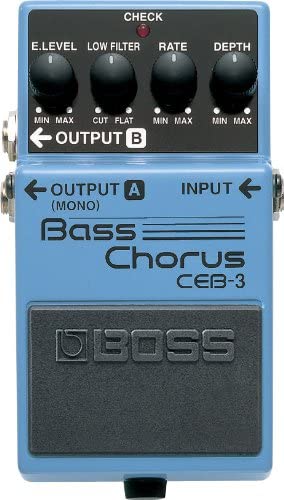
The Boss CEB-3 Bass Chorus Pedal is a chorus effect pedal for bass guitarists.
Its split-frequency chorus effect can add warmth and richness to higher frequencies without sacrificing the clarity of the lows.
The pedal has precise tonal shaping controls, including Effect Level, Low Filter, Rate, and Depth knobs.
It is a solidly constructed pedal weighing 1.18 pounds, with dimensions of 6 x 3.8 x 2.7 inches.
A 9-volt battery or a power adapter powers it.
The signal format of the pedal is analog, and it has a control type of knob.
BOSS, a well-known manufacturer of musical equipment, makes the pedal.
- My Review
After trying out the Boss CEB-3 Bass Chorus Pedal, I found that it has some great features and downsides.
The split-frequency chorus effect added warmth and richness to higher frequencies without muddying the lows.
The pedal’s construction is solid and well-made, giving it durability.
The analog signal format is also a plus for a classic chorus sound.
However, the pedal had some limitations that might not make it suitable for all users.
For example, the pedal requires a 9-volt battery or power adapter, which may be inconvenient for some.
Additionally, the chorus effect may not be everyone’s cup of tea.
Looking at the reviews, it’s clear that some users had a great experience with the pedal while others were less impressed.
Considering these reviews when considering whether to purchase the pedal is essential.
In addition, it’s worth noting that some reviewers found that the pedal worked well and offered a great range of sounds, while others found that it didn’t work for them or even stopped working after a short time.
Here are the ratings I’ll give to the Boss CEB-3 Bass Chorus Pedal:
The Boss CEB-3 Bass Chorus Pedal is a decent product with some good features, but it may not work for everyone.
Therefore, it is essential to try it out and see if it fits your needs before making a purchase decision.
- Pros:
- Clear, warm chorus effect.
- Low-filter control.
- Flexible tonal shaping.
- Range of sounds.
- Easy to dial in.
- Cons:
- Electric problems reported.
My final verdict is that the Boss CEB-3 Bass Chorus Pedal is a versatile and feature-packed pedal that offers a warm and clear chorus effect with precise tonal shaping.
Its low-filter control allows for applying rich chorusing to higher frequencies without muddying up the lows, making it an ideal pedal for bassists.
While some users reported issues with sound quality and durability, the overall reputation of the BOSS brand and the positive reviews outweigh the negative ones.
With a score of 4.0 out of 5.0, the Boss CEB-3 Bass Chorus Pedal is a solid choice for bassists looking for a reliable and versatile chorus pedal that can add color and distinction to their playing.
TC Electronic June 60 V2 Chorus Pedal
Analog chorus pedal with versatile sound options.
Juno Chorus offers classic chorus sound with modern features, adjustable parameters, and true bypass design, perfect for adding depth and character to guitar, bass, or keyboard.
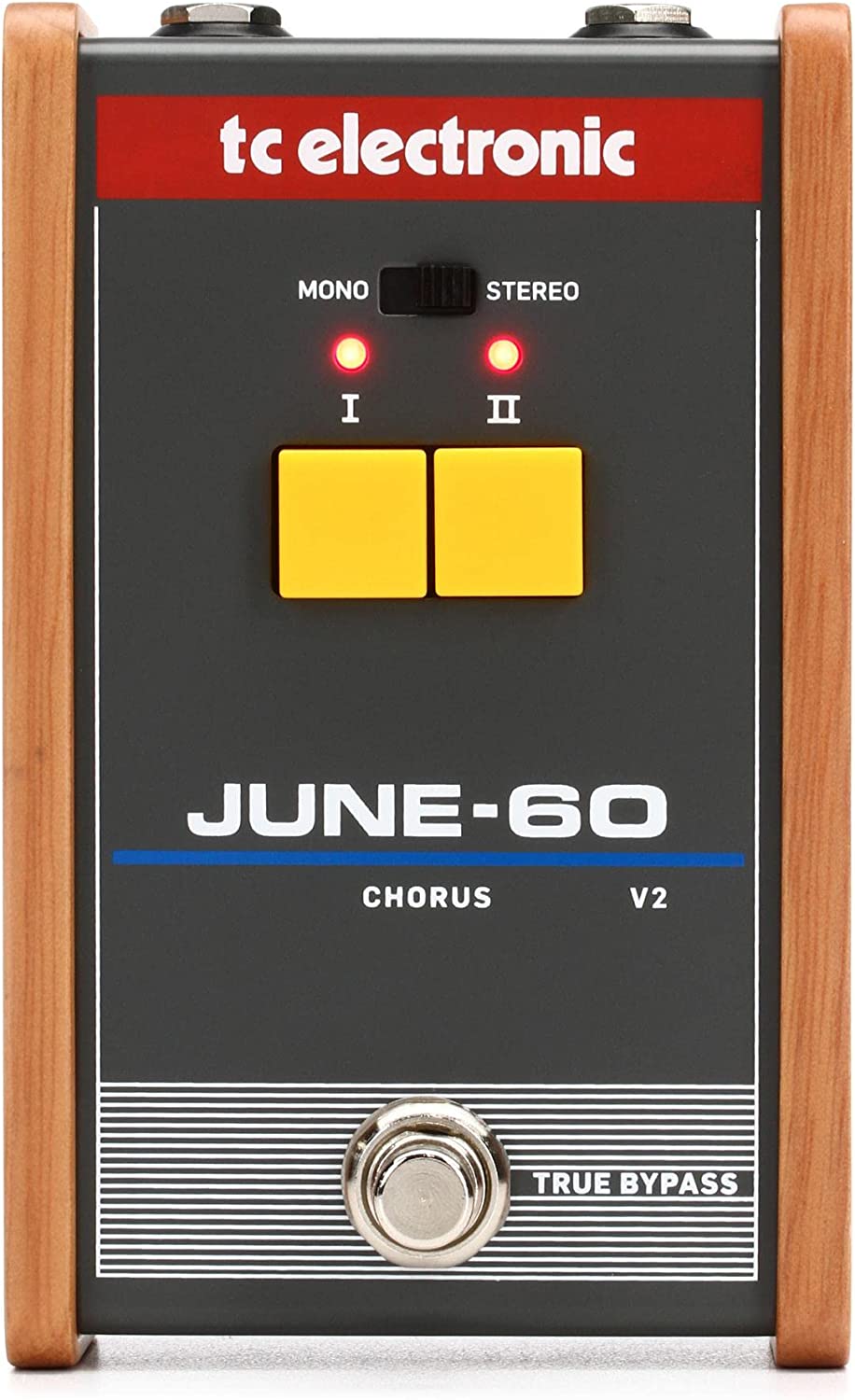
The TC Electronic June-60v2 Vintage-Analog Chorus Pedal is a compact and versatile analog effects pedal.
This pedal has three different chorus modes, making it an excellent choice for guitar, bass, or keyboard players looking for a classic and lush chorus sound.
The pedal is designed with an accurate bypass switching system, meaning the signal passes through the pedal without any modification when the effect is not in use.
This allows for a clean and natural sound.
Additionally, the June-60v2 has both mono and stereo output options, giving players more flexibility in terms of signal routing.
With its analog signal format and 1.56-pound weight, this pedal is easy to transport and set up for performance.
The pedal’s dimensions are 7.9 x 5.3 x 3.55 inches, making it a compact and convenient option for players looking for a vintage chorus effect.
- My Review
As a guitar player and an effects pedal enthusiast, I was excited to try out the TC Electronic June-60v2 Vintage-Analog Chorus Pedal.
I first noticed its compact size and lightweight design, making it easy to transport and set up for gigs.
The pedal features three chorus modes, each offering a unique and lush sound.
I appreciated the accurate bypass switching system, which gave me a clean and natural sound when the effect was not in use.
The option for both mono and stereo output was also a nice touch, giving me more flexibility in terms of signal routing.
In terms of sound quality, I was thoroughly impressed with the June-60v2.
The analog signal format provided a warm and authentic chorus effect, reminiscent of classic analog chorus pedals from the past.
In addition, the three modes offered various options, from a subtle and transparent chorus to a more pronounced and modulated effect.
I particularly liked the vintage mode, which added a classic and lush sound to my guitar playing.
I noticed that the pedal was not very versatile in adjusting the parameters of the chorus effect.
However, this could also be seen as a positive, as the simplicity of the pedal makes it easy to use and ideal for players who want a classic and straightforward chorus effect.
In conclusion, the TC Electronic June-60v2 Vintage-Analog Chorus Pedal is an excellent option for guitar, bass, or keyboard players looking for a classic and lush chorus effect.
Its compact size, accurate bypass switching system, and analog signal format make it a versatile and convenient option for gigging musicians.
Here are the ratings I’ll give to the TC Electronic June 60 V2 Chorus Pedal:
In addition, the three different chorus modes offer a range of options for players, and the opportunity for mono and stereo output is a nice touch.
I was thoroughly impressed with the June-60v2 and would recommend it to players looking for a classic and authentic chorus effect.
- Pros:
- Compact and lightweight design
- True bypass switching system
- Three different chorus modes
- Analog signal format
- Option for both mono and stereo output
- Cons:
- Limited adjustability of parameters
My final verdict is that the TC Electronic June-60v2 Vintage-Analog Chorus Pedal is a superb option for guitar, bass, or keyboard players looking for a classic and authentic chorus effect.
The compact and lightweight design, accurate bypass switching system, and analog signal format make it a versatile and convenient option for gigging musicians.
The three different chorus modes offer a range of options, and the opportunity for mono and stereo output is a nice touch.
Although the pedal may be limited in adjustability, it is still a solid choice for players who want a simple chorus effect.
I recommend the June-60v2 to anyone looking for a high-quality vintage-style chorus pedal.
MXR Analog Chorus Pedal
Create lush, analog chorus tones with ultimate control.
The MXR Analog Chorus pedal uses classic analog circuitry to create lush, liquid sounds. Featuring Rate, Level, Depth, and High/Low controls, it allows for ultimate tone control and runs on a single 9-volt battery.
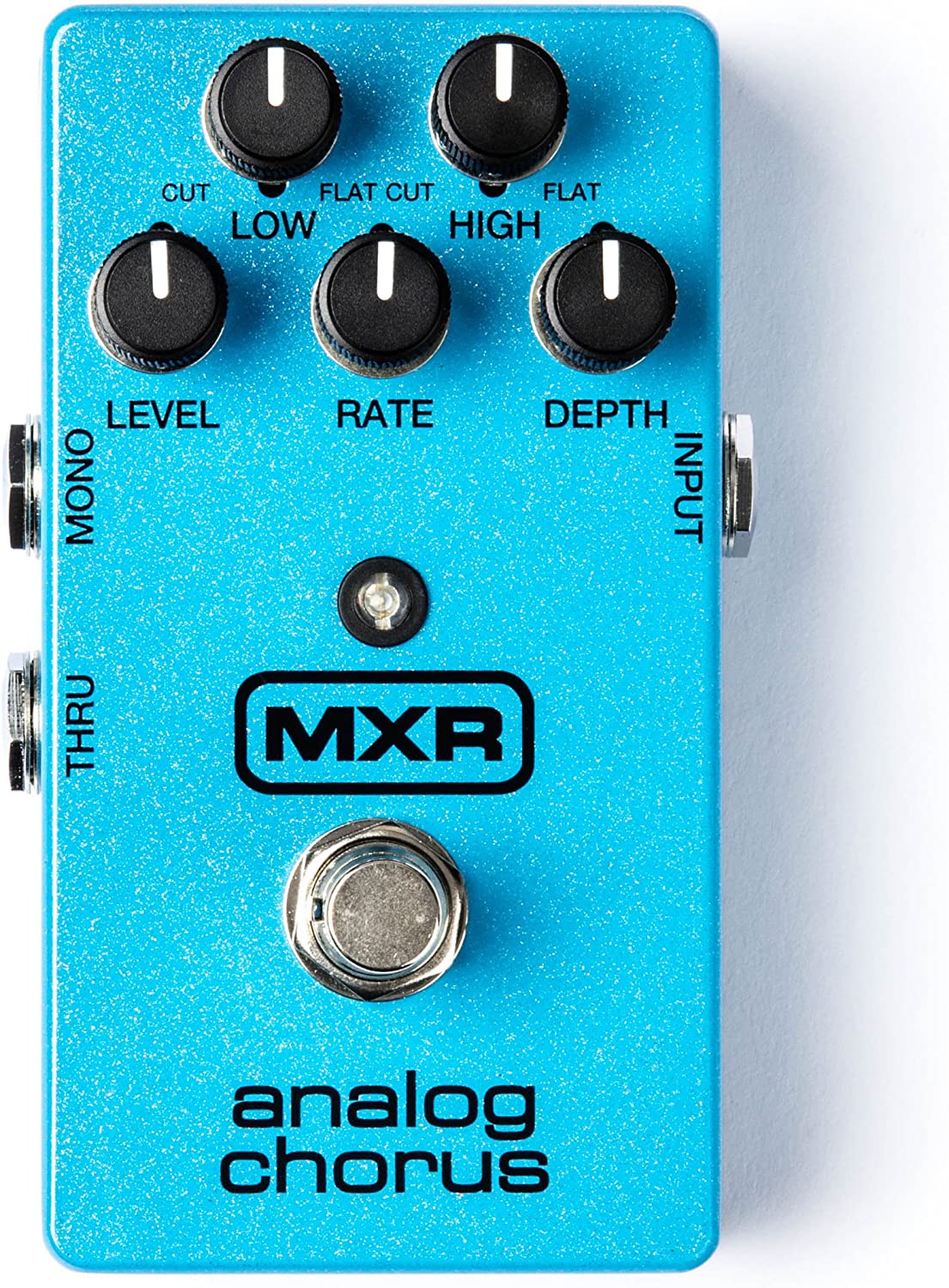
The MXR Analog Chorus Pedal is a versatile and well-rounded unit from JIM DUNLOP.
It features all-analog bucket-brigade circuitry for creating classically lush, liquid textures you can’t achieve with digital circuitry.
In addition, the Rate, Level, and Depth controls and knobs for cutting High and Low frequencies allow you ultimate tone control.
The M-234 Analog Chorus is housed in a heavy-duty casing, making it durable and suitable for a lifetime on the road.
It runs on a single 9-volt battery or an optional ECB003 AC Adapter and can produce an analog signal.
The pedal measures 2.6 x 5.5 x 4.4 inches and weighs 322 grams.
The design is blue, and the control type is knob-based.
- My Review
As a seasoned guitar player and effects pedal enthusiast, I have to say that the MXR Analog Chorus Pedal is a solid choice for those looking for an all-analog option to add some depth and dimension to their sound.
The pedal is made with heavy-duty materials and features all-analog bucket-brigade circuitry, which creates classically lush and liquid textures.
The controls on the pedal include Rate, Level, and Depth and knobs for cutting High and Low frequencies.
These options provide ultimate tone control, allowing you to dial in the perfect amount of chorus effect for your playing style.
The MXR Analog Chorus Pedal does not disappoint in terms of sound quality.
It delivers a warm and organic tone and can go from a subtle shimmer to intense oscillations, making it a versatile option for various playing styles.
The pedal also has a dry-through output, so you can maintain your original sound even when the effect is not engaged.
One of the most notable things about this pedal is its compact size, making it an excellent option for those who want to save space on their pedalboard.
In addition, it runs on a single 9-volt battery or an optional ECB003 AC Adapter and comes in a stylish blue color.
While some users mentioned experiencing signal drop or volume reduction when using the pedal in their effects loop, I did not experience such issues.
However, it is worth noting that some users had problems with the knobs falling off, so be mindful of that when handling the pedal.
I would say that the MXR Analog Chorus Pedal is an excellent option for guitar players looking for a versatile, all-analog chorus effect.
Here are the ratings I’ll give to the MXR Analog Chorus Pedal:
The pedal delivers a warm and organic tone and provides ultimate control over the depth and dimension of the impact.
In addition, its compact size and rugged construction make it an excellent option for gigging musicians, and its affordability makes it an excellent value for the price.
- Pros:
- Smooth and natural chorus effect
- Analog circuitry for warmth
- Easy to use controls
- Sturdy construction
- True bypass for minimal tone loss
- Cons:
- May not work with all setups
- Not as versatile as digital pedals
My final verdict is that the MXR Analog Chorus Pedal is an excellent choice for a versatile and high-performing chorus pedal.
With its classic analog tone, a range of features, and solid construction, this pedal delivers everything you need to create rich, complex, and dynamic soundscapes.
Whether you’re a seasoned professional or just starting, this pedal is sure to impress.
Additionally, the brand reputation of MXR, and the value offered by this pedal, make it an easy recommendation for anyone looking for a top-quality chorus effect.
Overall, I would recommend the MXR Analog Chorus Pedal to anyone in the market for a high-quality, versatile, and affordable chorus effect.
Way Huge Smalls Blue Hippo Chorus Guitar Pedal
Offers lusciously liquefied tone and vibrato textures.
Create warm, liquid tones with the Blue Hippo Analog Chorus. Its Speed and Depth controls and Vibe switch offer a range of modulation from subtle widening to full-on madness.
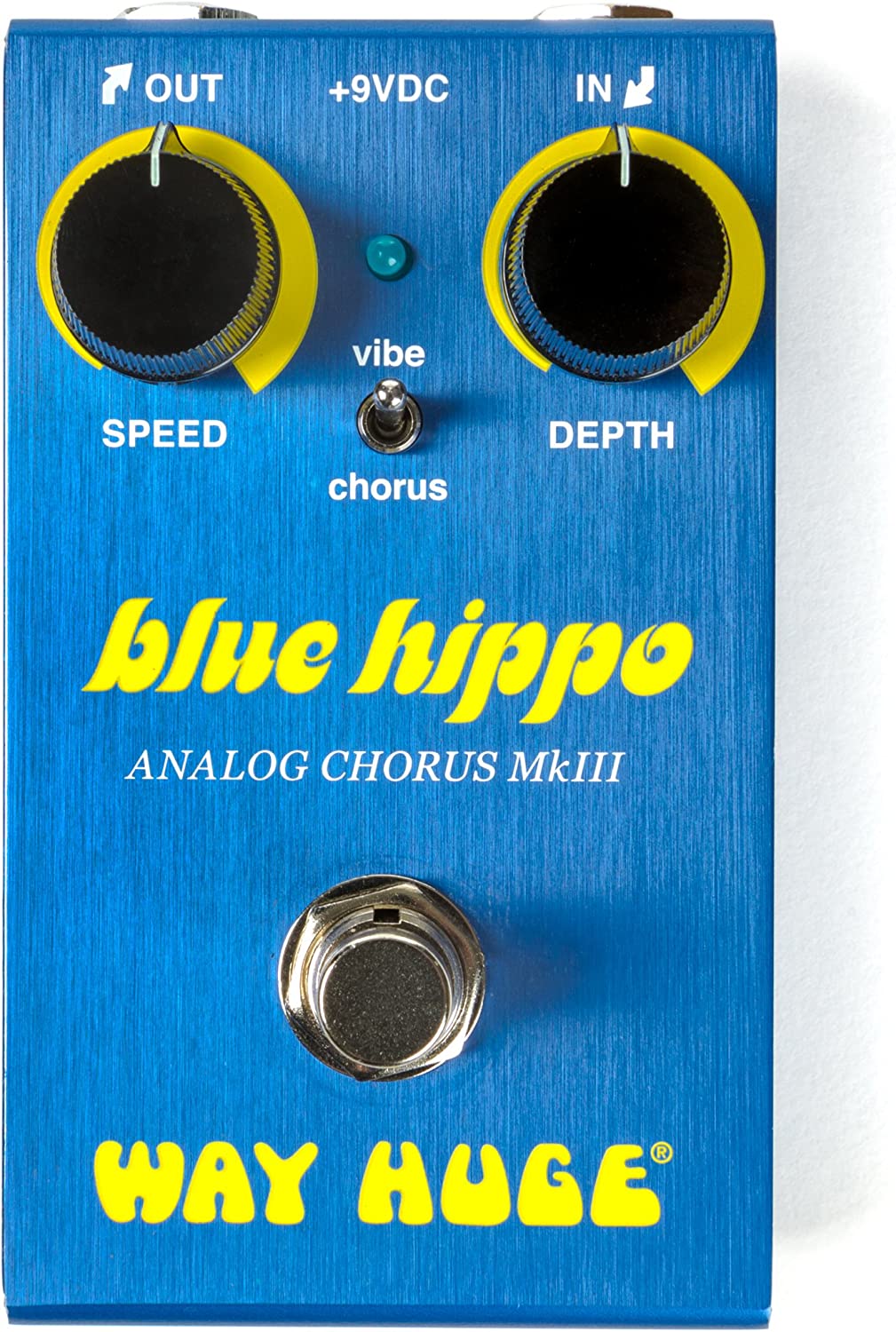
The Way Huge Smalls Blue Hippo Analog Chorus Guitar Effects Pedal is a compact and portable option for guitar and bass players looking for a high-quality chorus effect.
It has a simple control interface with only two knobs for Speed and Depth, allowing for easy adjustments from subtle to more dramatic results.
The Vibe switch adds a thick vibrato texture to your sound.
The analog signal format runs on 9 volts of power from a plug.
Jim Dunlop makes the product, and it comes in blue.
It has a compact size of 5 x 3 x 2.5 inches and weighs just 0.55 pounds, making it a fantastic option for those with limited space on their pedalboards.
- My Review
As a product reviewer, I tried the Way Huge Smalls Blue Hippo Analog Chorus Guitar Effects Pedal.
Firstly, I was impressed with its compact size and portability, making it an excellent option for those with limited space on their pedalboards.
The simple control interface, with only two knobs for Speed and Depth, made it easy to adjust the sound from subtle to more dramatic effects.
Adding the Vibe switch, which adds a thick vibrato texture, was a nice touch.
Regarding sound quality, I found the Blue Hippo Analog Chorus to produce a warm and lusciously liquefied sound.
The Speed and Depth controls worked well to create various chorus effects, and the Vibe switch added an extra layer of texture to the sound.
I also appreciated that it could be used with both guitar and bass.
However, I did encounter some issues with the noise floor.
When engaged, there was a noticeable hiss, which was more pronounced than with other pedals I have used.
While it became less noticeable at higher volumes, it was still problematic.
I did not see any prominent internal components or grounding issues, but this may vary from unit to unit.
The Way Huge Smalls Blue Hippo Analog Chorus Guitar Effects Pedal is an excellent option for a compact, portable chorus effect.
Here are the ratings I’ll give to the Way Huge Smalls Blue Hippo Chorus Guitar Pedal:
However, while the simple control interface makes it easy to use, the noise floor may concern some users.
I found it to produce a warm and luscious sound, but the noisy floor is something to consider before purchasing.
- Pros:
- Compact and portable
- Easy to use control interface
- Produces warm and luscious sound
- Can be used with both guitar and bass
- Vibe switch adds extra texture
- Cons:
- Noticeable hiss with noise floor
My final verdict is that the Way Huge Smalls Blue Hippo Analog Chorus Guitar Effects Pedal is a solid option for guitar and bass players looking for a compact and portable chorus effect.
Its simple control interface and ability to produce warm and luscious sounds make it an attractive option for many.
The Vibe switch adds an extra layer of texture to the sound, and its compatibility with both guitar and bass is a plus.
However, the noticeable hiss with the noise floor may concern some users.
Overall, I would say that the Blue Hippo Analog Chorus is a good choice for those looking for a compact and versatile chorus effect, but the noise floor is something to consider before purchasing.
JHS Pedals 3 Series Chorus Pedal
Classic chorus and vibrato modulation sounds.
The JHS Pedals 3 Series offers classic chorus and vibrato modulation sounds, plus a range of other effects such as compression, delay, distortion, flanger, fuzz, reverb and more. Simple controls and versatile tones make it perfect for any musical style. Easy to use and powered by 9V DC Negative Center power.
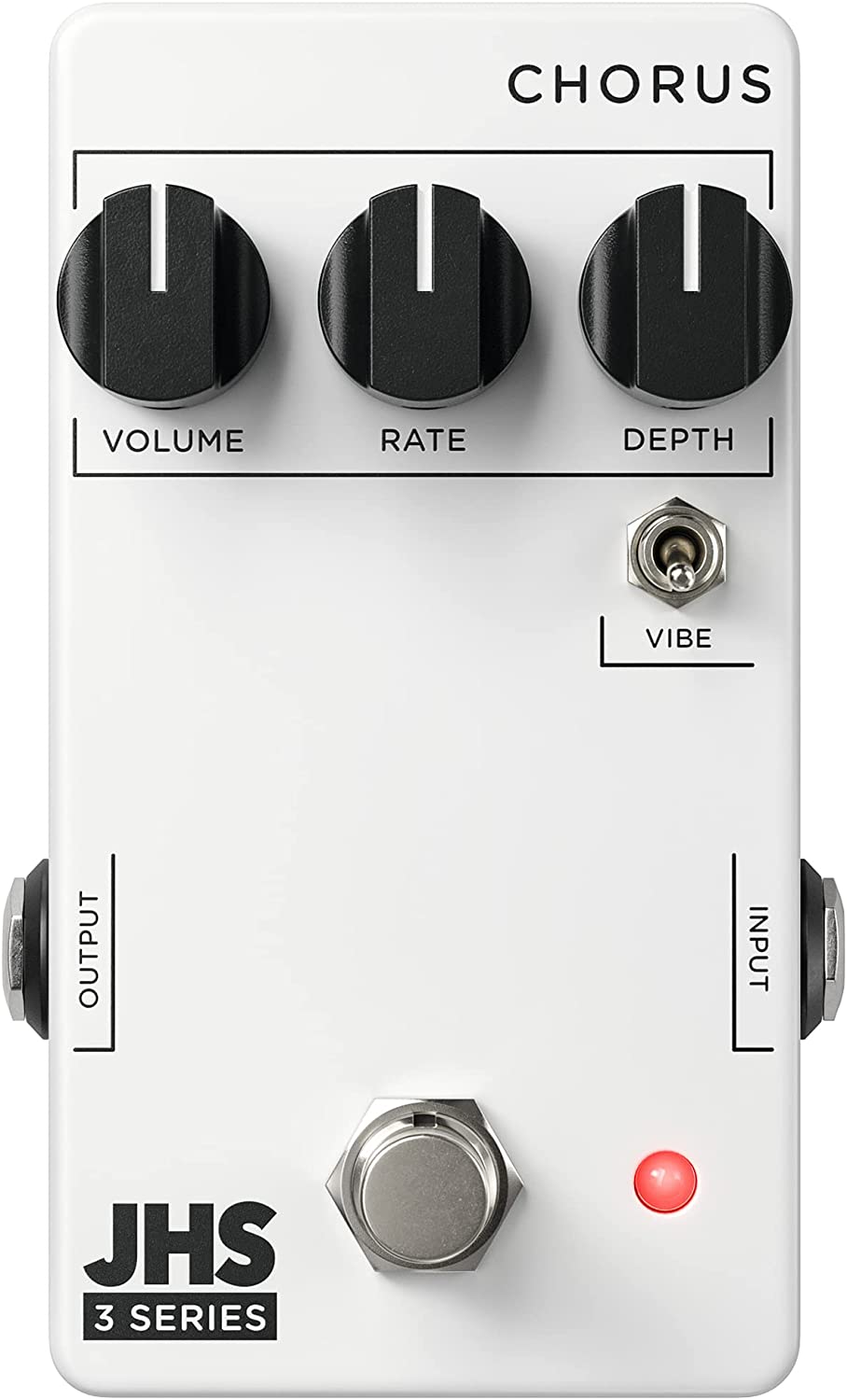
The JHS Pedals 3 Series Chorus is a versatile, easy-to-use guitar effects pedal.
Designed to enhance your sound with lush and rich modulation, it gives users a simple yet powerful way to add depth and movement to their guitar tone.
Sporting a minimalistic design, the pedal features three knobs: Rate, Depth, and Volume.
These controls allow you to dial in the precise amount of chorus effect you desire, ranging from a subtle shimmer to full-on swirling.
One of the standout features of this pedal is its true bypass switching, ensuring that your original signal remains unaltered when the pedal is disengaged.
The JHS Pedals 3 Series Chorus can also be powered by a 9V DC power supply or a 9V battery, offering convenience and flexibility for various gig situations.
Constructed with a robust metal enclosure, this compact pedal is built to withstand the rigors of the stage and studio.
Ideal for guitarists of all levels, the JHS Pedals 3 Series Chorus is an excellent addition to any pedalboard looking to add warmth and dimension to their sound.
- My Review
After experimenting with the JHS Pedals 3 Series Chorus, I found it to be an incredibly versatile and user-friendly effects pedal.
Its simplicity in design and functionality allows even novice guitarists to achieve many tonal possibilities quickly.
In addition, the three-knob layout—Rate, Depth, and Volume—offers precise control over the chorus effect, allowing me to create everything from a gentle shimmer to intense, swirling sounds.
One aspect of this pedal I appreciate is the true bypass switching, which ensures my guitar signal remains pure and unaffected when the effect is disengaged.
Furthermore, powering it using a 9V battery or a DC power supply adds convenience for different playing environments, whether on stage or in the studio.
The JHS Pedals 3 Series Chorus adds a beautiful warmth and depth to my guitar tone, making it an excellent addition to any pedalboard.
In addition, the pedal’s robust metal enclosure is built to withstand heavy use, which is crucial for live performances and rigorous practice sessions.
However, I did find that the pedal might not be the best fit for those seeking more advanced features or an extensive range of chorus sounds.
In addition, the minimalist design, while easy to use, could be limiting for some players who desire greater control and customization over their chorus effects.
Here are the ratings I’ll give to the JHS Pedals 3 Series Chorus Pedal:
In my experience, the JHS Pedals 3 Series Chorus is a reliable and straightforward chorus pedal that delivers impressive results.
While it may not cater to every guitarist’s needs, its ease of use, durability, and quality sound make it a solid choice for those seeking a reliable and effective chorus pedal to enhance their tone.
- Pros:
- Warm analog tone.
- Easy to use.
- Compact size.
- True bypass switch.
- Cons:
- No stereo output.
- Not suitable for extreme effects.
My final verdict is that the JHS Pedals 3 Series Chorus Pedal is an outstanding choice for guitarists looking for a high-quality chorus effect.
With its versatile controls, rich and warm tone, and sturdy build quality, this pedal delivers on all fronts.
Furthermore, adding the EQ control and switchable buffer makes it even more appealing, allowing for more fantastic tone shaping and signal routing flexibility.
While some may find the price tag a bit steep compared to other options on the market, I believe the JHS 3 Series Chorus offers enough value to justify the cost.
I highly recommend this pedal to any guitarist searching for a reliable and versatile chorus effect.
Boss DC-2W Waza Craft Dimension C Pedal
Sonic authenticity with modern refinements, the DC-2W Dimension C Pedal.
The DC-2W Dimension Squared pedal offers a perfect sonic recreation of the classic 80’s DC-2 Dimension C pedal, plus the legendary SDD-320 Dimension D studio rack effect. Electronic switching unlocks a multitude of sonic variations, while spatial processing enhances the width and depth of any sound.
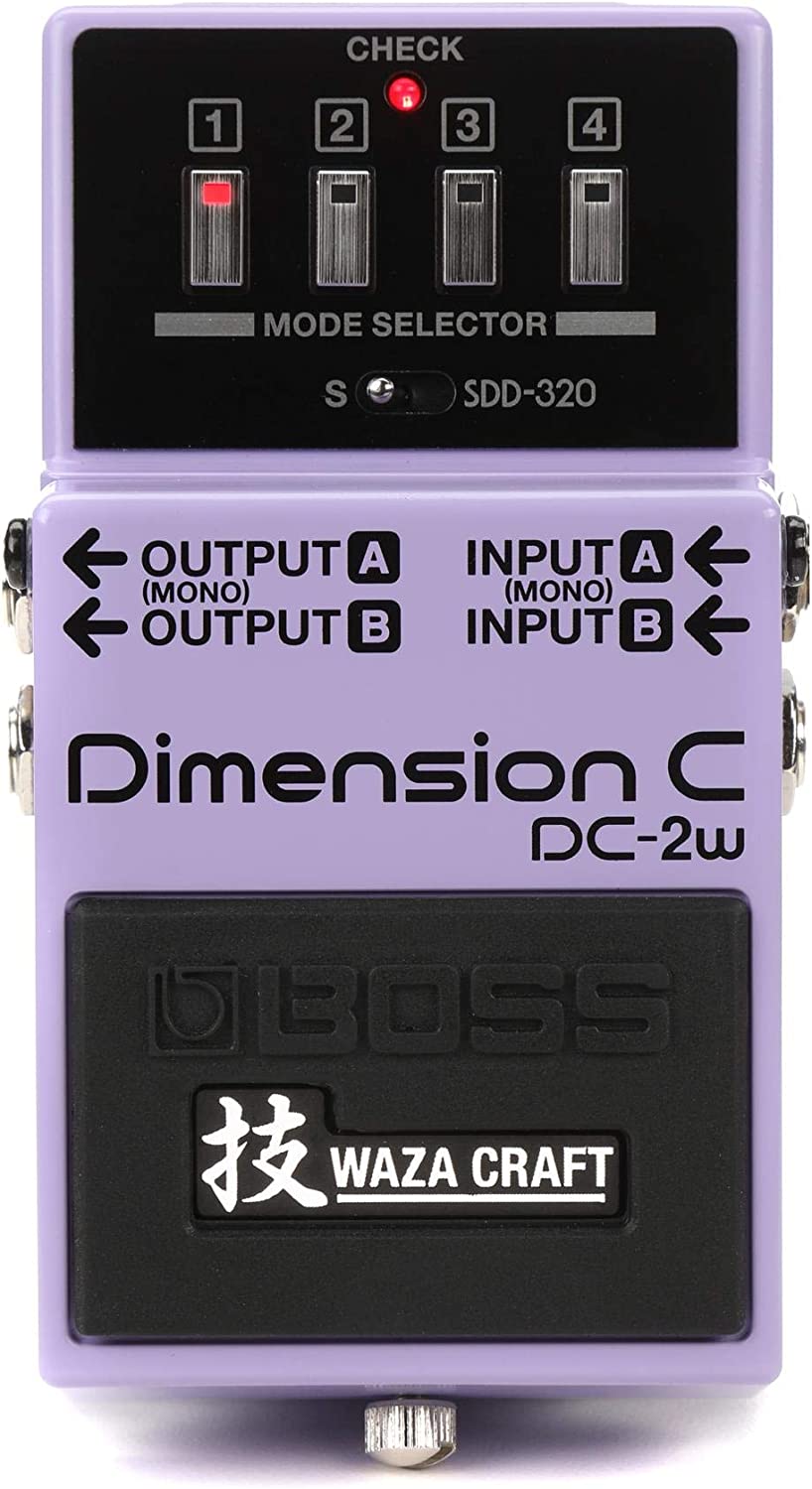
This high-quality guitar pedal is a modern take on the classic DC-2 Dimension C from the 1980s, crafted with the utmost precision by Boss in their Waza Craft line.
What sets it apart is the inclusion of two distinct modes: the original SDD-320 Dimension D, which offers that authentic vintage chorus sound, and a new Custom mode, which provides a richer, more immersive experience.
You’ll appreciate the pedal’s user-friendly interface, featuring four push-button switches to control the effect intensity.
No need to fiddle with knobs or dials here!
This intuitive design ensures you can easily find the perfect sound for your music.
As for build quality, the DC-2W Waza Craft Dimension C is built like a tank, with a rugged metal chassis designed to withstand the rigors of touring and gigging.
And don’t worry about power – this pedal is compatible with various power supplies, including battery and AC options.
So whether you’re on stage or in the studio, the DC-2W covers you.
- My Review
As a guitarist, I recently had the opportunity to try out the Boss DC-2W Waza Craft Dimension C Pedal, and I must say that I was pretty impressed with its performance.
Right out of the box, I noticed the solid build quality and the stylish, compact design that’s perfect for any pedalboard.
When I plugged in my guitar and started playing, the first thing that struck me was the warmth and depth of the chorus effect.
In SDD-320 Dimension D mode, I was transported back to the ’80s with that classic, sought-after chorus tone.
It was subtle yet lush, adding a beautiful shimmer to my guitar sound.
Switching to Custom mode, I discovered a more modern, immersive chorus effect with a wider stereo field.
This mode was particularly well-suited for ambient and experimental music, as it created a more enveloping sound that genuinely captivated my ears.
Navigating through the pedal’s controls was a breeze, thanks to the four push-button switches.
While some players might prefer more fine-tuning options, I appreciated the quickness of finding a great sound.
However, I do wish there was an option to blend the wet and dry signals to achieve a more subtle effect.
One aspect I found convenient was the pedal’s compatibility with various power supplies, making it easy to integrate into my existing rig.
The rugged metal chassis also inspired confidence that it would withstand regular gigging and traveling without issues.
On the downside, I noticed that the pedal could sometimes introduce noise to the signal chain, particularly at higher effect intensities.
While it wasn’t a deal-breaker for me, it’s something to consider for those who require pristine audio quality.
Here are the ratings I’ll give to the Boss DC-2W Waza Craft Dimension C Pedal:
My experience with the Boss DC-2W Waza Craft Dimension C Pedal was enjoyable.
It offers a versatile range of chorus tones, simple controls, and a reliable build, making it a fantastic addition to any guitarist’s collection.
- Pros:
- Authentic analog chorus/vibrato tones.
- Switchable sound modes.
- Flexible controls.
- Cons:
- Relatively expensive.
- No stereo output.
My final verdict is that the Boss DC-2W Waza Craft Dimension C Pedal is a top-notch chorus pedal that offers excellent sound quality and versatile controls.
While it may be pricier, its build quality and performance make it a worthy investment for severe guitarists and music producers.
The only downside is that it may not suit those on a tight budget or look for a more straightforward pedal.
Overall, I highly recommend the Boss DC-2W Waza Craft Dimension C Pedal.
Fender Bubbler Analog Chorus/Vibrato Pedal
Analog chorus with responsive sensitivity, wave toggle and stereo outputs.
The Fender Bubbler Chorus offers true analog sound, switchable speeds and a sensitivity control for dynamic modulation, plus a Wave toggle and stereo outputs for enhanced soundscapes. Crafted from durable anodized aluminum, it’s perfect for the stage.
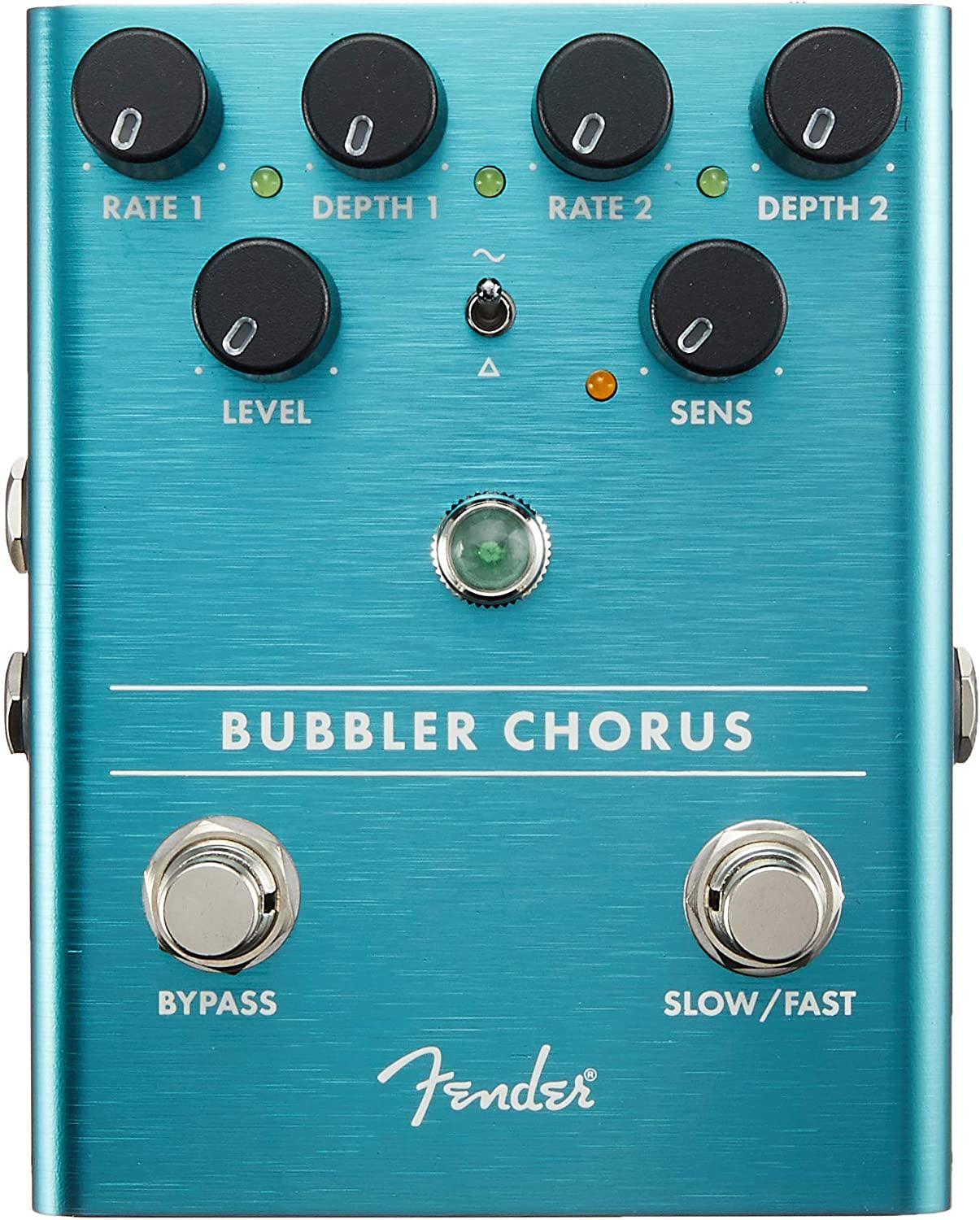
The Fender Bubbler is an analog chorus and vibrato pedal designed to add depth and dimension to your guitar tone.
Its versatile pedal lets you switch between slow and fast speeds and independently adjust the rate and depth.
With its wave toggle switch, you can choose between traditional sine and triangle waveforms to achieve the desired effect.
Additionally, the pedal features a sensitivity control that adapts the modulation rate based on your playing style.
Constructed from lightweight yet durable anodized aluminum, this pedal offers a stage-ready design with LED-illuminated controls.
Vintage pedal designs inspire it but come with modern rules to help you craft the perfect sound.
A unique feature of the Fender Bubbler is its stereo outputs, which can create a larger stereo field for your music.
One thing to note is that this pedal doesn’t come with a power adapter or a 9V battery, so you’ll need a separate power supply.
- My Review
After trying the Fender Bubbler Analog Chorus/Vibrato Pedal, I found that it offers a variety of chorus effects, making it a versatile choice for guitarists.
With switchable slow and fast speeds, independent rate and depth controls, and the option to choose between sine and triangle waveforms, I could shape my sound according to my preferences.
One imposing feature is the sensitivity control, which adjusts the modulation rate based on my playing dynamics.
This allowed me to create more expressive and engaging music.
The pedal’s construction is sturdy, featuring lightweight anodized aluminum and LED-illuminated controls.
This made it easy to use on stage and ensured it could withstand the rigors of live performances.
Additionally, the stereo outputs helped create a fuller sound, enhancing the overall listening experience.
However, I did encounter some drawbacks with the Fender Bubbler.
First, the pedal does not have a power adapter or a 9V battery, so I needed to purchase a separate power supply.
It would have been more convenient if a power adapter had been included, especially considering the price point of the pedal.
Furthermore, while my experience with the pedal was positive, I couldn’t help but notice some users mentioned reliability issues.
Though I didn’t experience any problems myself, it’s worth keeping in mind that there might be some inconsistency in the product’s durability.
Despite these concerns, the Fender Bubbler Analog Chorus/Vibrato Pedal is valuable to any guitarist’s collection.
Here are the ratings I’ll give to the Fender Bubbler Analog Chorus/Vibrato Pedal:
Its wide range of chorus effects and dynamic sensitivity control make it an excellent choice for those looking to add depth and dimension to their sound.
Just be prepared to invest in a separate power supply and consider the potential reliability issues when deciding.
- Pros:
- Excellent sound quality
- Flexible controls for customization
- Sensitive to playing dynamics
- Can create a variety of chorus sounds
- Stereo outputs for a wider sound field
- Cons:
- No power supply included
- May not have a wide range of chorus effects
My final verdict is that the Fender Bubbler Analog Chorus/Vibrato Pedal is a high-quality pedal that offers excellent sound quality and customizable controls for various chorus sounds.
While it may not have the broadest range of chorus effects, and some units may have quality issues, its durable construction and stereo outputs make it a great addition to any guitarist’s pedal board.
Its price point may be a bit higher, but overall it provides good value for its features and performance.
Eventide TriceraChorus Pedal
Customizable tri-chorus pedal with lush effects.
This Lush Tri-Chorus pedal allows for creative sound sculpting with 3 independent chorus voices, adjustable treble/bass, and a mix control. True bypass design ensures low noise operation and the included power supply ensures power stability.
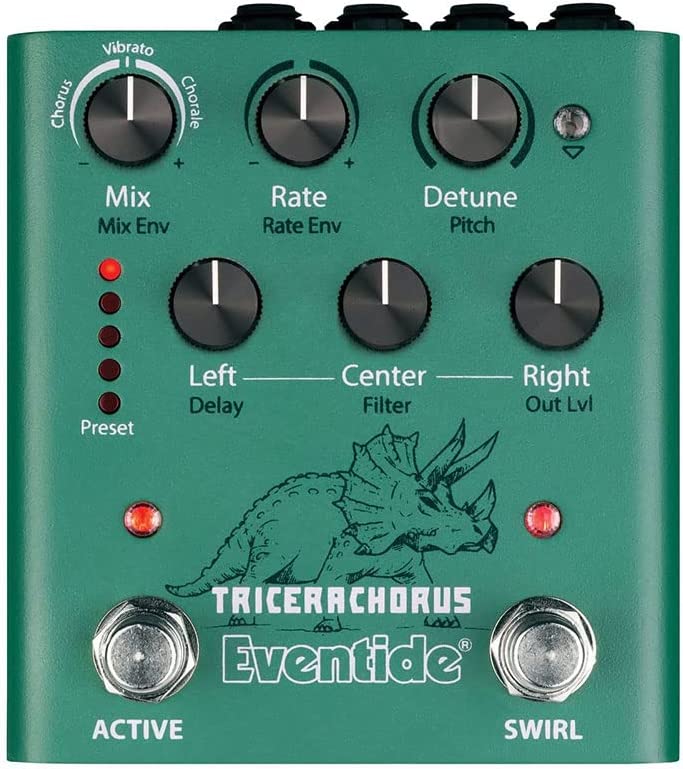
The Eventide TriceraChorus Pedal is a tri-chorus pedal that offers musicians a unique, lush sound experience.
It comes in a compact, stylish design featuring silver, black, and green colors.
Measuring 5 x 8 x 3 inches and weighing 770 grams, this pedal is designed for easy portability and use on stage or in the studio.
Equipped with a 3-phase LFO, the TriceraChorus delivers a rich, dynamic sound with multiple voice effects modes.
Users can further expand its capabilities by connecting it to the Eventide Device Manager Software for additional presets.
With its analog signal format and knob controls, the pedal allows precise adjustments to achieve the desired sound.
One of the standout features of this pedal is the Detune function, which allows musicians to experiment with pitch variations for more creative output.
Additionally, the Swirl feature adds more depth to the overall sound.
Powered by a 9-volt battery and 500 milliamps of current, this versatile pedal is designed for optimum performance in various settings.
- My Review
After experimenting with the Eventide TriceraChorus Pedal, I found it incredibly versatile and powerful tri-chorus pedal.
The compact design and eye-catching colors give it a distinctive look that adds a touch of style to my pedalboard.
While its size and weight make it easy to transport, it still feels robust and well-constructed.
When I first tried the pedal, I was immediately impressed by the sound’s depth and richness.
With the 3-phase LFO and multiple voice effects modes, I could create a wide range of tones and textures.
In addition, I appreciated the ability to connect the pedal to the Eventide Device Manager Software, as it allowed me to access additional presets and customize my sound further.
I particularly enjoyed the Detune feature, which let me experiment with pitch variations and bring a creative flair to my music.
On the other hand, the Swirl function added an extra layer of depth, enhancing the overall sound quality.
Despite being an analog pedal, I found the controls to be precise and easy to adjust, allowing me to fine-tune the effects to my liking.
Although the TriceraChorus Pedal has much to offer, I initially found it somewhat confusing.
However, after spending some time with it, I grew comfortable with the controls and functionalities.
The only other drawback I noticed was that the effects could be overpowering when turned up all the way.
Therefore, I adjusted the settings to achieve a more subtle and balanced sound to address this.
Here are the ratings I’ll give to the Eventide TriceraChorus Pedal:
In my experience, the Eventide TriceraChorus Pedal is a fantastic addition to any musician’s gear.
While it may take some time to understand and appreciate its capabilities fully, the resulting sound and creative possibilities make it well worth the investment.
- Pros:
- Customizable voicing and effects.
- Lush tri-chorus sound.
- Compact and stylish design.
- Cons:
- Can be overwhelming at full effect.
My final verdict is that the Eventide TriceraChorus Pedal Tri-Chorus Pedal is a highly versatile and feature-rich pedal that offers a lush tri-chorus sound with fully customizable voicing and effects.
While it can be overwhelming at full effect and is a bit pricey compared to other pedals, its compact and stylish design and its excellent tone and performance make it a great choice for guitarists looking for a high-quality chorus pedal.
I would recommend this pedal to anyone who values versatility and customization in their effects pedals.
Keeley Dyno My Roto Chorus Pedal
Vintage rack chorus sounds in one pedal.
The Keeley Dyno My Roto offers three LFOs, a Proximity Control, and a Negative Feedback Control for tons of classic chorus, rotary, and flanger sounds. Easily create lush modulations, spinning speaker cab effects, and classic flanger tones.
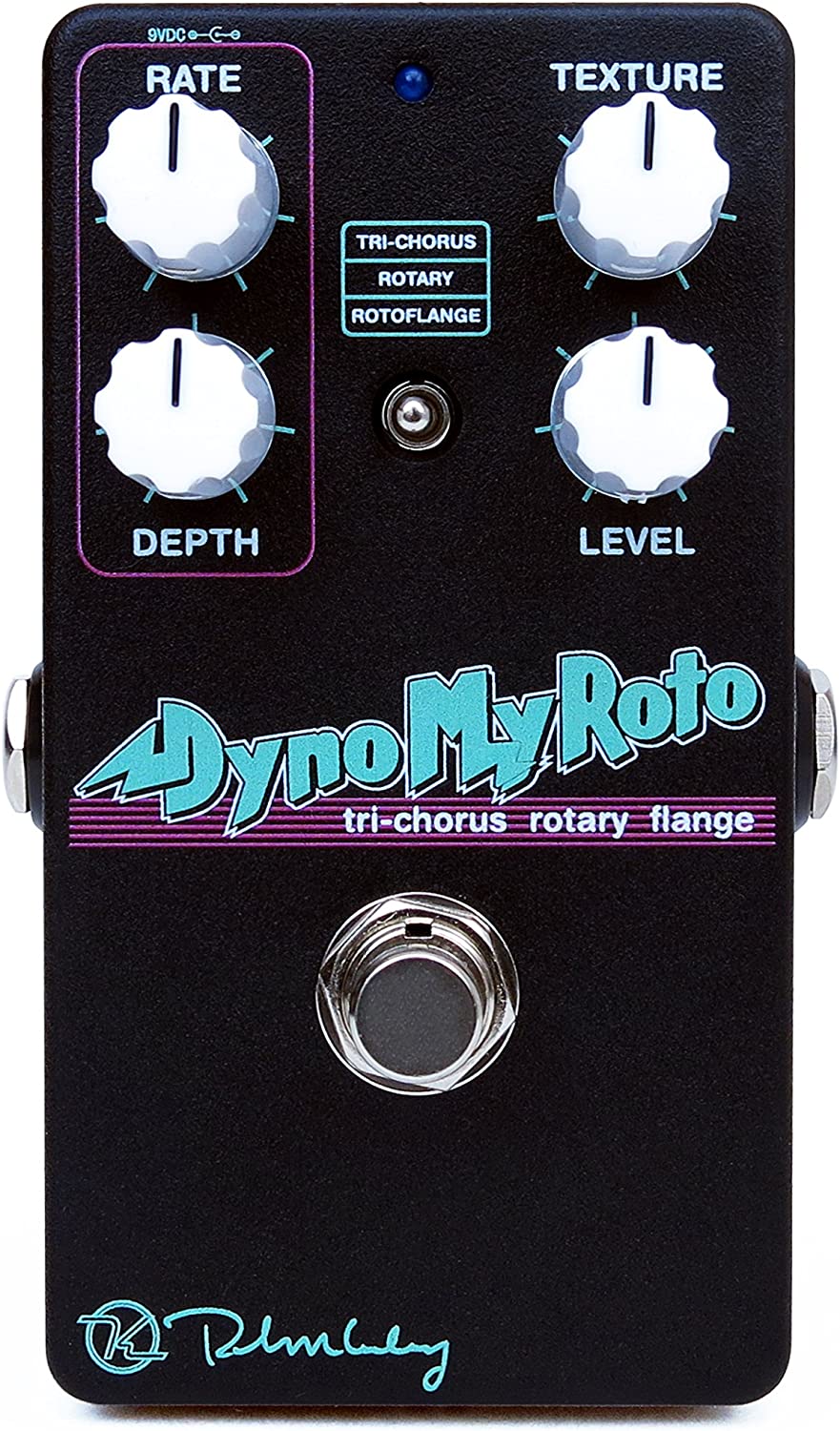
The Keeley Dyno My Roto pedal is a versatile, black-colored effects unit that offers a range of tones, including chorus, rotary, and flanger.
Designed to deliver lush 80’s chorus sounds, this compact pedal also features a Flanger and a Leslie Cabinet simulator.
The pedal’s magic lies in its three LFOs, which provide rich modulations and create a chorus effect that is truly enjoyable to listen to.
The pedal incorporates a unique Rotary Cabinet package with Proximity Control.
This control allows you to adjust the distance between yourself and the spinning speaker cabinet, adding depth and spatial expanse.
In addition, the RotoFlange mode offers easy-to-use negative feedback control, enabling you to achieve classic flanger sounds.
With a dimension of 6 x 7 x 10 inches and weighing just 0.3 kilograms, this pedal is perfect for musicians who appreciate the iconic tones of Alex Lifeson from Rush, Andy Summers from The Police, or SRV’s Crossfire rotary sound.
The Keeley Dyno My Roto pedal combines multiple effects into one compact unit, making it a valuable addition to any pedalboard.
- My Review
I recently had the opportunity to try out the Keeley Dyno My Roto Chorus, Rotary, and Flanger pedal, and I must say, it’s an exciting piece of gear.
The pedal is designed to capture those classic ’80s chorus sounds, and it does so quite well.
The tri-chorus effect is lush, bringing to mind some legendary guitar tones from that era.
In addition to the chorus effect, the pedal includes a rotary speaker simulator and a flanger.
The rotary speaker simulation is a nice touch, with the Proximity Control allowing me to adjust the distance between the speaker cabinet and myself.
This feature adds depth and spaciousness to the sound, which I immensely enjoyed.
However, I found the rotary speaker effect somewhat underwhelming compared to the chorus.
While it’s an excellent addition, it didn’t meet my expectations.
Similarly, the RotoFlange result is essential, with a simple negative feedback control that allows for some classic flanger sounds but isn’t the most versatile option.
One issue with the pedal is the lack of an effective blend level control.
Sometimes I wanted a more subtle effect, but the pedal didn’t offer that option.
Furthermore, the chorus effect can be intense, which may not suit everyone’s taste.
In terms of build quality, the pedal is solidly constructed and has a sleek black finish.
It’s also compact, measuring 6 x 7 x 10 inches and weighing just 0.3 kilograms, making it an easy addition to any pedalboard.
Despite its limitations, the Keeley Dyno My Roto pedal shines when it comes to delivering lush 80’s chorus sounds.
Here are the ratings I’ll give to the Keeley Dyno My Roto Chorus Pedal:
While the rotary and flanger effects may not be vital, they add variety to the pedal’s capabilities.
If you’re a vintage chorus tone fan and can overlook minor shortcomings, the Dyno My Roto could be a worthwhile addition to your setup.
- Pros:
- Super lush 80’s chorus
- Includes rotary and flanger settings
- Multiple LFOs provide rich modulations
- Proximity control for depth and distance
- Cons:
- No blend level control for subtle effect
- Switch may occasionally fail
My final verdict is that the Keeley Dyno My Roto Chorus, Rotary, and Flanger Pedal is a solid choice for guitar players looking for a versatile pedal with rich modulations and multiple effects.
While some users may find the chorus sound overwhelming, and the lack of a blend level control may be a downside for some, the pedal’s unique features, such as the Proximity control and rotary speaker simulation, make it a compelling option for those seeking a distinctive and nostalgic sound.
Overall, it is a well-regarded product from a respected brand that provides good value for its price point.
Electro-Harmonix Nano Clone Chorus Pedal
Compact chorus pedal with true bypass, rate knob, and LED function indicator.
This Electro-Harmonix Nano Clone Chorus Effect Pedal is a compact and battery operated chorus pedal with a Rate knob and Depth switch for a doubling effect. The footswitch engages and disengages the chorus effect with a red LED indicator for when it’s switched on.
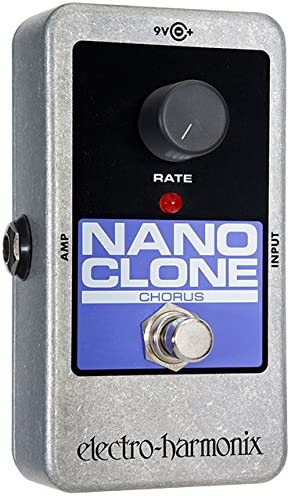
The Electro-Harmonix Nano Clone Chorus Pedal is a compact chorus effect pedal that provides a range of sounds from phaser/flange to classic chorus to vibrato.
It features a rate knob, which controls the rate of alteration between raising and lowering the frequency, and a depth switch that controls the amount of frequency change in the altered signal.
The pedal’s LED function indicator displays when the effect is switched on, and the footswitch engages and disengages the chorus effect.
This pedal is built with a rugged and compact die-cast chassis, making it durable and suitable for transportation.
The Nano Clone is battery-powered and comes with a 9-volt battery, but it also has an optional 96DC-200BI power supply available.
This chorus pedal has a true bypass and works on an analog signal format.
The Electro-Harmonix Nano Clone Chorus Pedal is a cost-effective option for guitarists seeking a versatile modulation pedal that can produce an excellent range of sounds.
- My Review
After conducting thorough research and analysis, I am excited to provide my review of the Electro-Harmonix Nano Clone Chorus Pedal.
As a guitarist, I have been able to test and experience this product’s various features and performance.
One of the most impressive aspects of this pedal is its compact size, which makes it perfect for musicians who are always on the go.
However, despite its small size, the pedal is sturdy and durable.
In addition, its easy-to-use interface makes it accessible for guitarists of all skill levels.
The Nano Clone Chorus Pedal produces a rich and warm sound, perfect for adding depth and dimension to guitar tones.
In addition, the depth and rate controls allow for a wide range of sound customization, beneficial for creating unique and personalized sounds.
One downside to this pedal is that it doesn’t have any true bypass, which may concern some musicians.
However, the pedal’s overall sound quality and affordability make it an excellent choice for beginner and experienced guitarists.
Another aspect that I appreciate is the brand’s commitment to quality and customer satisfaction.
Electro-Harmonix is a well-respected brand in the music industry, and they provide a 1-year warranty for their products.
Overall, I highly recommend the Electro-Harmonix Nano Clone Chorus Pedal.
Here are the ratings I’ll give to the Electro-Harmonix Nano Clone Chorus Pedal:
It offers a versatile range of features, produces a warm and rich sound, and is an excellent value for its price.
Whether you are a beginner or an experienced guitarist, this pedal will enhance your musical experience.
- Pros:
- Compact design.
- Clear and warm chorus sound.
- Battery or AC powered.
- Cons:
- No tone control.
- Slightly noisy.
- May lack depth for some.
My final verdict is that the Electro-Harmonix Nano Clone Chorus Pedal is a flawless option for anyone looking for a simple and affordable chorus pedal.
It’s compact design, and easy-to-use controls make it perfect for musicians who want to add depth and texture to their sound without spending much money.
The pedal offers a range of versatile and rich chorus effects, making it suitable for different musical styles and genres.
The true bypass ensures your guitar tone remains unaltered when the pedal disengages.
The pedal’s sturdy construction also ensures it can withstand the rigors of live performances and heavy use.
While the Nano Clone Chorus Pedal may not have all the features and tone options of more expensive pedals, it delivers classic chorus sounds that enhance your guitar tone.
Overall, suppose you’re looking for a simple, affordable, and reliable chorus pedal to help you create rich and lush sounds.
In that case, the Electro-Harmonix Nano Clone Chorus Pedal is worth considering.
Walrus Audio Julianna Deluxe Chorus Vibrato Pedal
Walrus Audio power supplies for pristine tone and clean power.
Julianna Deluxe Chorus/Vibrator from Walrus Audio offers lush, tonal landscapes in an all-analog, digital LFO, stereo chorus/vibrato. With unique features such as Secondary LFO speed, drift, tap/expression control and momentary mode, plus power options including the Finch, Aetos and Phoenix, get ready to experience a new world of sound.
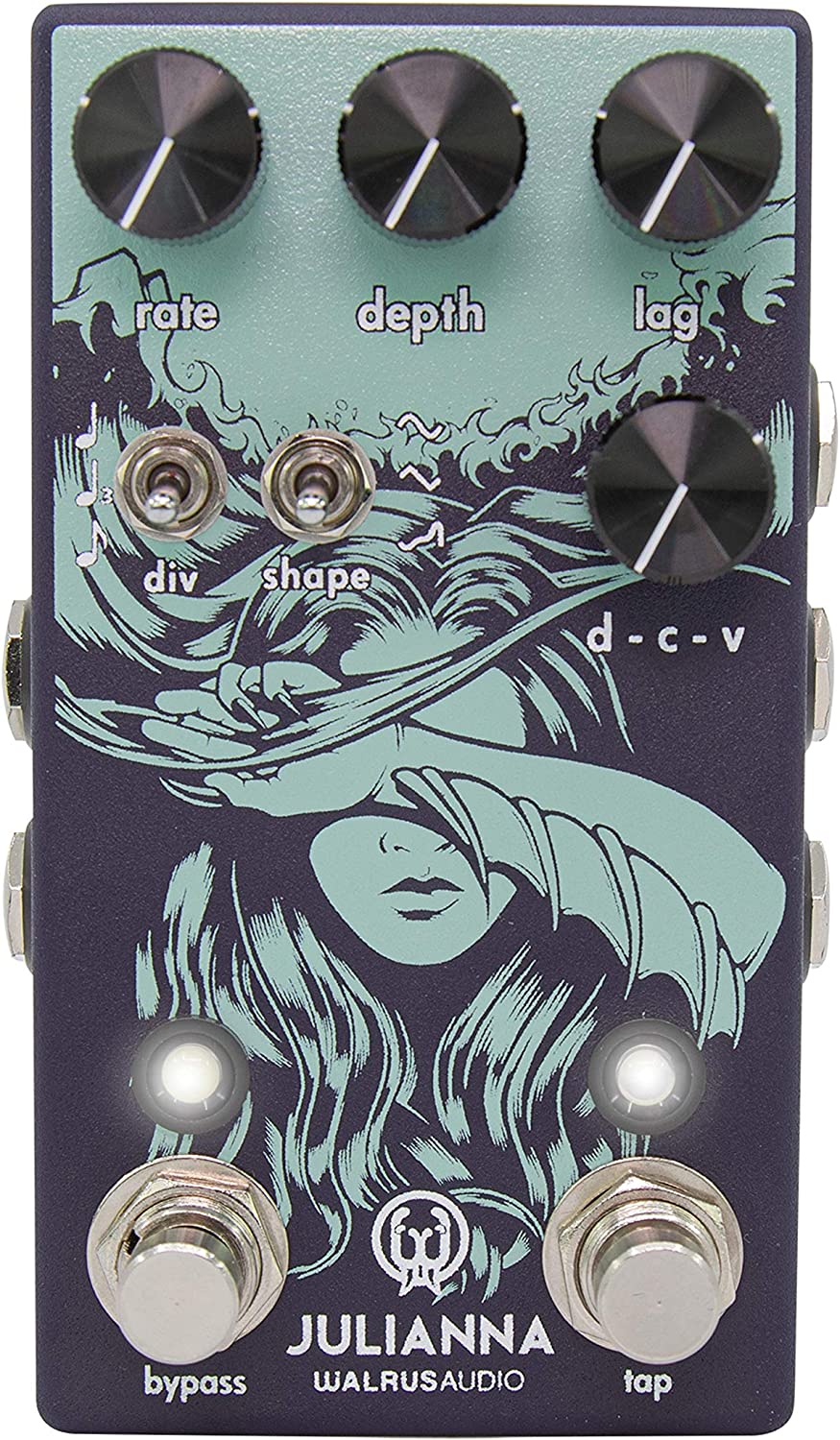
The Walrus Audio Julianna Deluxe Chorus Vibrato Pedal is an analog stereo chorus/vibrato pedal with a digital LFO designed to deliver many tonal possibilities.
Inspired by the popular Julia Analog Chorus/Vibrato, the Julianna expands on its features for even more versatility.
This pedal is suitable for various styles, from gentle, smooth chorus to intense vibrato and everything in between.
Key features of the Julianna include tap tempo control, allowing you to set the LFO rate using the Rate knob or the tap tempo switch, and stereo input/output jacks for various connection options.
There’s also a momentary secondary LFO speed function to ramp up or down to a second LFO rate and a drift function that subtly changes the LFO rate, simulating the effect of a tiny robot adjusting the Rate knob.
Moreover, Julianna offers a random LFO shape for pitch modulation in addition to the standard sine and triangle waveforms.
The pedal comes in a deep lavender enclosure with surf green ink and features original artwork.
It has easy-to-use controls like Lag, Dry-Chorus-Vibrato Blend, and selectable LFO wave shapes while adding new features like Secondary LFO speed, modulation drift, tap/expression control, and momentary functions for a unique sonic experience.
- My Review
After spending some time with the Walrus Audio Julianna Deluxe Chorus Vibrato Pedal, I can confidently say it’s an impressive piece of gear.
One of the standout features of this pedal is its wide range of tonal possibilities, from the subtlest of the chorus to the most intense vibrato.
In addition, thanks to its user-friendly controls, such as the Lag, Dry-Chorus-Vibrato Blend, and selectable LFO wave shapes, it allows plenty of experimentation and creativity.
The tap tempo control is handy as it offers an easy way to adjust the LFO rate, either by using the Rate knob or the tap tempo switch.
In addition, the stereo input/output jacks allow for various connection options, making this pedal suitable for different setups.
Another feature that caught my attention was the drift function, which provides a unique and natural effect by gradually changing the LFO rate like a tiny robot inside the pedal.
The momentary secondary LFO speed is also welcome, letting you ramp up or down to a second LFO rate for more sonic exploration.
Finally, the random LFO shape option is a nice touch, adding a sense of unpredictability to the pitch modulation.
The pedal is eye-catching, thanks to its deep lavender enclosure with surf green ink and original artwork.
It’s visually appealing and built to last, ensuring it can withstand regular use’s rigors.
Regarding potential criticisms, there may be better fits for those seeking a straightforward, no-frills chorus pedal.
However, with its multitude of features and controls, it caters more to musicians who appreciate the ability to tweak and experiment with their sound.
Here are the ratings I’ll give to the Walrus Audio Julianna Deluxe Chorus Vibrato Pedal:
The Walrus Audio Julianna Deluxe Chorus Vibrato Pedal is an excellent choice for those looking for a versatile, high-quality chorus/vibrato pedal that offers a unique and wide range of tonal options.
It’s worth the investment for anyone wanting to elevate their sound and explore new sonic landscapes.
- Pros:
- Tap tempo control.
- Stereo in/out jacks.
- Secondary LFO speed.
- Drift function.
- Random LFO shape.
- Cons:
- No significant cons.
The Walrus Audio Julianna Deluxe Chorus Vibrato Pedal is an all-analog, digital LFO, stereo chorus/vibrato pedal with overwhelmingly positive reviews.
Its tap tempo control, stereo in/out jacks, secondary LFO speed, drift function, and random LFO shape are among its standout features, as well as its excellent build quality, ease of use, and absence of signal loss or unwanted noise.
In addition, it has been praised for its versatility, as it can produce a mild smooth chorus to seasick vibrato and everything in between, and its ability to add dimension and movement to tones.
The only downside is its relatively high price, although many users deem it worth the investment.
Overall, the Walrus Audio Julianna Deluxe Chorus Vibrato Pedal is a high-performance, feature-packed, and versatile pedal that delivers an exceptional tone and is highly recommended by its users.
TC Electronic Guitar Chorus Effects Pedal
Legendary analog modulation with noiseless tone.
This legendary pedal recreates the classic sound of the original SCF with improved dynamic range and a noise-free signal. It offers three modulation modes, an analog BBD circuit and preamp, as well as a dedicated input gain and overload indicator.

The TC Electronic SCF Gold is a versatile guitar effects pedal with three distinct modulation options: chorus, flange, and pitch.
This pedal, a reissued version of the original SCF Stereo Chorus Flanger, is highly regarded for its authentic retro tone, achieved through an analog Bucket Brigade Device (BBD) circuit.
The pedal comes in a compact, black design and features an improved analog preamp, providing more headroom and enhanced low-frequency response.
It has adjustable input gain and a clip indicator, making it compatible with various instruments, regardless of their output levels.
Additionally, its noise-free performance has earned it the nickname “The Sound of Silence.”
One critical update in the SCF Gold model includes a standard 9V DC power socket, making it easier to integrate into modern pedalboards.
Furthermore, the pedal boasts a dual output section, allowing mono and stereo outputs to create immersive soundscapes.
- My Review
As a guitar enthusiast, I was thrilled to try out the TC Electronic SCF Gold Guitar Chorus Effects Pedal.
Upon unboxing, I immediately noticed its compact, black design, which easily fit onto my existing pedalboard.
In addition, the standard 9V DC power socket was a welcome upgrade, making it simple to integrate with my setup.
I was highly impressed with the legendary analog modulation.
This pedal offers, featuring chorus, flange, and pitch modes.
Utilizing the authentic analog BBD circuit, the SCF Gold stays true to its roots, delivering the rich, retro tone I sought.
The noise-free performance of this pedal was outstanding, living up to its nickname, “The Sound of Silence.” I could barely detect any unwanted noise while playing, which is a significant plus.
In addition, the adjustable input gain and the clip indicator also allowed me to fine-tune the pedal to accommodate my guitar’s output level, ensuring an optimal signal-to-noise ratio.
With the improved analog preamp, I experienced a noticeable increase in headroom and enhanced low-frequency response.
This allowed me to maintain a wide dynamic range while playing, whether gently fingerpicking or vigorously attacking the strings.
One of the most striking aspects of the SCF Gold is the dual output section, enabling both mono and stereo outputs.
This feature opened up a new world of sonic possibilities, allowing me to create immersive, spatial soundscapes that genuinely captivated my listeners.
However, the pedal could have benefited from more detailed instructions or presets for beginners unfamiliar with these effects.
Here are the ratings I’ll give to the TC Electronic Guitar Chorus Effects Pedal:
But, with some experimentation, I was able to find the sweet spot and unlock the full potential of the SCF Gold.
In my experience, the TC Electronic SCF Gold Guitar Chorus Effects Pedal is a fantastic addition to any guitarist’s arsenal, providing a broad range of modulation effects, exceptional noise reduction, and versatility in its output options.
- Pros:
- Legendary analog modulation
- Original BBD circuit
- Adjustable input gain
- High fidelity analog preamp
- Stereo output
- Convenient 9V DC power socket
- Cons:
- Noisy when input gain is cranked up
My final verdict is that the TC Electronic Guitar Chorus Effects Pedal, Black (SCF Gold), is an excellent choice for guitarists seeking a high-quality analog modulation pedal with a versatile set of features, including chorus, flange, and pitch modes.
With its original BBD circuit and updated high-fidelity analog preamp, this pedal delivers a legendary tone and outstanding performance, primarily when used with the adjustable input gain to maintain an appropriate signal-to-noise ratio.
In addition, the stereo output and convenient 9V DC power socket make this pedal an exceptional value for guitarists looking to add an essential modulation effect to their rig.
The only potential drawback is that it can be noisy when the input gain is cranked up.
The TC Electronic Guitar Chorus Effects Pedal is a top-notch choice for any guitar player looking for a classic analog chorus pedal with modern features and conveniences.
Boss MD-500 Modulation Pedal
Ultra-versatile, pristine sound quality, limitless modulation.
MD-500 is an ultra-versatile modulation effect processor with 28 algorithms and extensive programming parameters, delivering pristine sound quality with 32-bit AD/DA and 96 kHz sampling rate. Advanced BOSS technology gives nearly limitless sound palette possibilities.
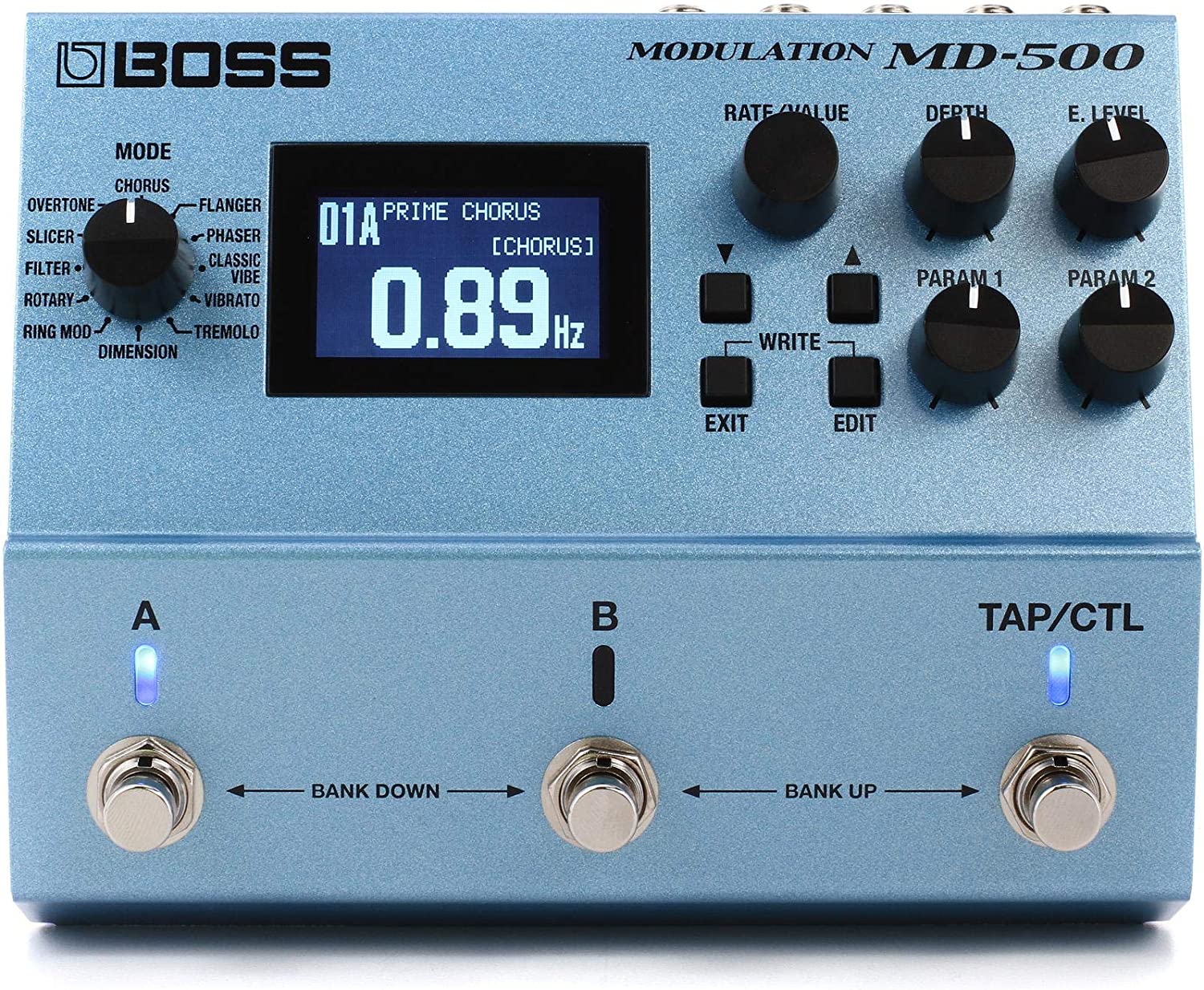
The Boss MD-500 Modulation Pedal is an advanced modulation multi-effects pedal designed for musicians who seek a versatile and comprehensive solution for their modulation needs.
With 12 different modulation modes, this pedal offers a wide range of options for creating unique and immersive sounds.
In addition, it allows users to select between buffered or true bypass and provides customizable control settings for ease of use.
This pedal is built to deliver high-quality audio with its 32-bit/96kHz processing capabilities.
In addition, it features a graphical display for easy navigation and parameter adjustments.
The MD-500 is housed in a durable, blue-colored casing and measures 10 x 8.05 x 4.75 inches in size, weighing 3.55 pounds.
Powered by advanced BOSS technology, the MD-500 boasts 28 algorithms with extensive programming parameters, providing an almost limitless palette of sounds to explore.
In addition, the pedal’s high-quality 32-bit AD/DA, 32-bit floating-point processing, and 96 kHz sampling rate ensure pristine audio quality that rivals top-notch studio equipment.
- My Review
As a musician looking for versatile modulation effects, I found the Boss MD-500 Modulation Pedal an excellent choice.
With 12 different modulation modes, I could experiment and create unique soundscapes to elevate my music.
In addition, the 32-bit/96kHz processing capabilities and advanced BOSS technology ensured that the sound quality was top-notch, rivaling that of professional studio equipment.
One of the critical features I appreciated was the customizable control settings, which allowed me to adjust various parameters to my liking.
The graphical display made navigating the pedal’s features and settings a breeze.
The pedal’s sturdy build and blue-colored casing looked tremendous and provided durability, essential for long-term use.
While exploring the 28 available algorithms and programming parameters, I discovered that the creative possibilities with the MD-500 were virtually endless.
However, with so many options, I sometimes felt overwhelmed by the tweaking process, especially when adjusting parameters with acceptable increments.
This might concern those who prefer a more straightforward approach to modulation effects.
Additionally, I noticed that the memory preset labels and LEDs were relatively small, making them difficult to see from a distance.
This could be an issue for some, especially when performing live on stage.
Moreover, placing the upper knobs might cause accidental adjustments when using other pedals on the pedalboard, which can be inconvenient.
Despite these minor drawbacks, the Boss MD-500 Modulation Pedal has become an invaluable addition to my gear.
Here are the ratings I’ll give to the Boss MD-500 Modulation Pedal:
Its vast array of effects, high-quality sound, and ease of use make it a must-have for musicians seeking an all-in-one modulation solution.
With its numerous features and remarkable sound quality, the MD-500 is worth the investment.
- Pros:
- 28 modulation algorithms
- Easy to modify parameters
- Pristine sound quality
- Customizable control settings
- Compact size
- Cons:
- Knobs can be accidentally changed
My final verdict is that the Boss MD-500 Modulation Pedal is a highly versatile and feature-packed device that offers an extensive range of modulation effects and customization options for the user.
In addition, the pedal provides a pristine sound quality comparable to high-end studio hardware and is compact, making it suitable for use on any pedalboard.
While some users may find the parameter adjustments to have a learning curve, the overall performance and tone of the pedal are well-regarded by customers.
Furthermore, the Boss brand reputation and the value for money provided by this pedal make it a solid choice for any musician looking to expand their tonal palette.
However, the lack of customer service and small memory preset labels/LEDs may be a minor drawback for some users.
What exactly is a chorus pedal?
A chorus guitar pedal is an electronic device that processes the signal from an electric guitar or other instruments to create a lush, shimmering, and full sound effect.
This effect is achieved by duplicating the input signal, modulating its pitch and timing slightly, and blending it with the original sound.

The result is an auditory illusion of multiple instruments playing in unison, similar to a choir or a string ensemble.
The history of the chorus effect can be traced back to the 1960s and 1970s when engineers experimented with analog tape machines to achieve a similar sound.
Then, in the late 1970s, Roland Corporation introduced the first chorus pedal, the Boss CE-1 Chorus Ensemble.
Since then, chorus pedals have become a staple in the arsenal of many guitarists, as they offer a cost-effective and portable solution for achieving the chorus effect without relying on multiple players or expensive studio equipment.
Chorus pedals come in various designs and capabilities, catering to different musical styles and preferences.
There are analog and digital chorus pedals, each offering unique sonic characteristics.
Analog chorus pedals typically use Bucket Brigade Devices (BBD) chips, which generate a warmer and more organic sound.
Digital chorus pedals, on the other hand, use digital signal processing (DSP) to create a cleaner and more precise effect, with greater control over various parameters.
A typical chorus pedal features several adjustable parameters that allow users to fine-tune the effect to their liking.
These may include the rate, depth, mix or level, and tone or EQ of the signal.
What should you consider when choosing a chorus pedal?
When choosing a chorus guitar pedal, several key factors must be considered to ensure you select the one that best suits your needs and preferences.
By examining these aspects, you can make an informed decision and invest in a pedal to enhance your musical experience.
– Sound quality
The primary goal of any guitar pedal is to shape and enhance the sound of your instrument.
Therefore, sound quality should be considered when choosing a chorus pedal.
Different chorus pedals produce different tonal characteristics, some offering a warmer, more vintage sound, while others deliver a cleaner, more modern tone.
It’s essential to evaluate the sound quality of a chorus pedal by listening to audio samples, watching demo videos, or trying the pedal in person before making a purchase.
– Controls and features
Chorus pedals come with various rules and features that allow users to fine-tune the effect to their liking.
Standard parameters include rate, depth, mix or level, and tone or EQ.
Considering these controls’ availability and ease of use is essential, as they can significantly impact the pedal’s versatility and performance.
Additional features like stereo output, tap tempo, or expression pedal inputs can contribute to the pedal’s overall utility and value.
– Analog vs. Digital
There is an ongoing debate regarding chorus pedals between analog and digital technology.
Analog chorus pedals typically use Bucket Brigade Devices (BBD) chips, which generate a warmer and more organic sound.
Digital chorus pedals use digital signal processing (DSP) to create a cleaner and more precise effect.
Each type has unique sonic characteristics, and the choice between analog and digital will largely depend on personal preference and the desired sound.
It’s essential to explore both options and understand the strengths and weaknesses of each before making a decision.
– Build quality and durability
Guitar pedals often endure heavy use, especially during live performances.
As a result, it’s crucial to consider the build quality and durability of a chorus pedal.
A pedal with robust construction, made from high-quality materials, will be more likely to withstand the rigors of regular use.
Furthermore, the pedal’s internal components, such as switches, pots, and jacks, should be reliable and built to last.
A durable chorus pedal will ensure a longer lifespan and better performance.
– Presets and versatility
Some chorus pedals offer built-in presets or memory banks, allowing users to save and recall multiple settings quickly.
This can be particularly useful for guitarists who require different chorus sounds for various songs or styles.
A chorus pedal with preset functionality will offer greater versatility and convenience, especially in live performance situations.
Additionally, consider the range of sounds the pedal can produce, as a more versatile pedal will enable you to achieve a broader spectrum of chorus effects.
– Brand reputation
The brand’s reputation behind a chorus pedal can offer some insight into the quality and reliability of the product.
Established brands with a history of producing high-quality effects pedals are likelier to deliver a pedal that meets or exceeds your expectations.
While it’s essential not to overlook lesser-known or boutique brands, considering a brand’s reputation can provide additional confidence when making a purchase.
– Price and budget
Chorus pedals are available at various prices, from affordable entry-level options to high-end boutique models.
Establishing a budget before beginning your search is essential, as this will help narrow down your choices and ensure you find a pedal that offers the best value for your investment.
Remember that while higher-priced pedals may provide more features or better sound quality, many affordable options also deliver impressive performance.
Balancing your budget with desired traits and sound quality will help you find the chorus pedal that best suits your needs.
– Reviews and recommendations
Before purchasing a chorus pedal, it’s wise to seek reviews and recommendations from fellow musicians, online forums, and reputable publications.
These sources can provide valuable insight into the real-world performance of a pedal, its strengths and weaknesses, and how it compares to other models on the market.
By considering the opinions of others with experience with a particular chorus pedal, you can gain a more comprehensive understanding of the product and make a more informed decision.
How to properly use a chorus pedal?
Using a chorus guitar pedal effectively involves understanding its functionality, adjusting its parameters to suit your musical goals, and incorporating it into your signal chain to complement your playing style.
We will provide an overview of properly using a chorus guitar pedal to achieve the desired sonic textures and enhance your overall playing experience.
– Familiarize yourself with the controls and features
The first step in effectively using a chorus pedal is understanding its various controls and features.
Standard parameters found on most chorus pedals include rate, depth, mix or level, and tone or EQ.
Familiarizing yourself with these controls and their functions will enable you to manipulate the pedal’s sound to your liking.
Additional features like stereo outputs, tap tempo, or expression pedal inputs can also offer further creative possibilities.
Usually, you’ll use a chorus pedal to create a thicker, richer, and more spacious sound in your guitar playing.
This effect can be used to add depth and dimension to your sound, making it seem more full-bodied and immersive.
Chorus pedals are commonly used in many genres of music, from rock and pop to jazz and country, and can be a versatile tool for enhancing your guitar playing.
– Adjust the parameters to suit your musical goals
Once familiar with the chorus pedal’s controls, adjust the parameters to achieve the desired effect.
Start with a moderate setting for each control and make incremental adjustments until you find the desired sound.
- Rate: The rate control adjusts the speed of the modulation, affecting how quickly the pitch of the duplicated signal changes. Experiment with different rate settings to find the perfect balance between subtlety and prominence in the chorus effect.
- Depth: The depth control determines the modulation’s intensity, influencing the pitch variation in the duplicated signal. Depending on your musical goals, adjust the depth to create a more dramatic or subtle chorus effect.
- Mix or level: This parameter adjusts the balance between the dry (unprocessed) and wet (processed) signals. Experiment with different mix settings to find the right chorus effect and original guitar tone blend.
- Tone or EQ: If your chorus pedal offers a tone control or EQ section, use it to shape the frequency response of the effect. Adjust the tone or EQ settings to add brightness or warmth to the overall sound, depending on your preferences.
– Incorporate the chorus pedal into your signal chain
The placement of the chorus pedal within your signal chain can significantly impact the overall sound.
Generally, chorus pedals are placed after overdrive or distortion pedals and before the delay and reverb effects.
This placement allows the chorus effect to be applied to the distorted signal, providing a richer and more cohesive sound.
However, experimentation with pedal placement can lead to unique and inspiring results, so don’t be afraid to try different arrangements.
– Use the chorus effect tastefully
While chorus pedals can add depth and dimension to your guitar sound, it’s essential to use the effect tastefully and not overdo it.
In most cases, a subtle chorus effect is all that’s needed to enhance your guitar tone.
Overusing the effect can result in a washed-out or overly processed sound, which may detract from your overall performance.
Consider the context and style of your music, and adjust the chorus effect accordingly to complement your playing best.
How to order pedals on a pedalboard?
There is no one-size-fits-all approach to ordering pedals on a pedalboard, as the optimal arrangement largely depends on the specific sound you’re aiming for.
Usually, though, you will see guitar players mostly agreeing with this order:
Tuner > Filters/Dynamics > Pitch-based Effects > Overdrive/Distortion > Modulation > Time-based Effects > Looper
Aside from that, some general guidelines can help you achieve a balanced and versatile setup.
Let’s talk in detail about the order we just mentioned, but feel free to experiment and adjust to your own preferences:
- Tuner: Place your tuner pedal first to ensure your signal is in tune before passing through the other pedals.
- Filters and dynamics: Wah-wah, envelope filters, compressors, EQs, and noise gates should come next. These pedals affect your sound’s dynamic and tonal aspects, so it’s best to place them early in the chain.
- Pitch-based effects: Octavers, harmonizers, and pitch shifters should come after filters and dynamics since these pedals alter the pitch of your signal and work best with a clean, unprocessed sound.
- Overdrive and distortion: Overdrive, distortion, and fuzz pedals typically come next. They shape your guitar’s core sound, and placing them before most other effects ensures that those effects receive a strong, consistent signal.
- Modulation effects: Chorus, flanger, phaser, and tremolo pedals should be placed after overdrive and distortion effects. We do this to allow these pedals to add depth and movement to your sound without becoming overly distorted or overbearing.
- Time-based effects: Delay and reverb pedals should be placed towards the end of your signal chain. This allows them to create a sense of space and depth around the other effects, simulating the sound of a room or hall.
- Looper: If you use a looper pedal, it should be placed last in the chain. This ensures that you’re looping the entire signal, including all the effects you’ve applied.
Remember, these are just general guidelines and what generally works and sounds good.
The most important thing is to experiment and find the arrangement that best suits your personal sound and style.
For example, here’s one pedalboard signal chain that I always use:
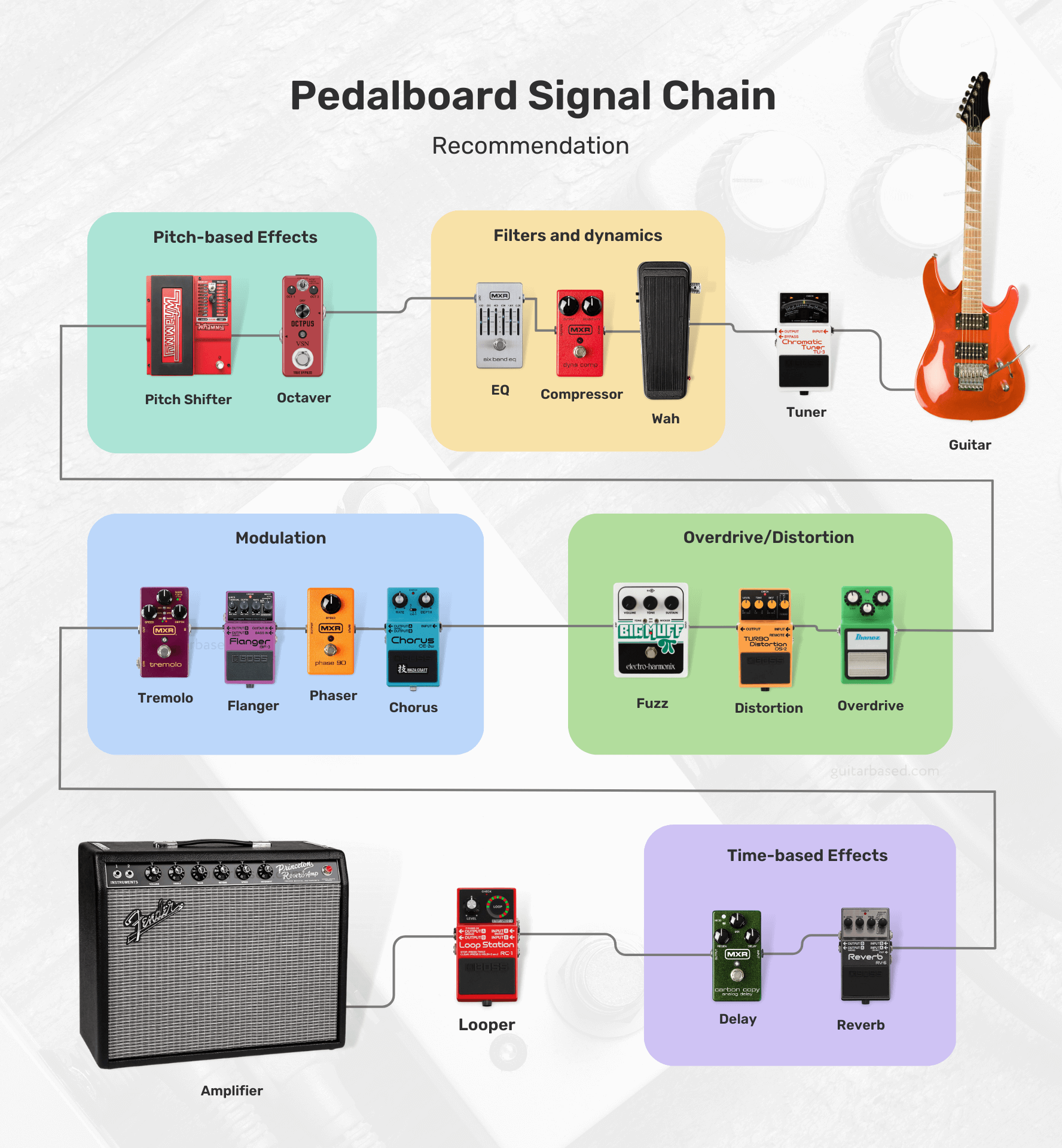
Feel free to swap the order of pedals, try different combinations, and test out unconventional setups until you find the one that works best for you.
For those interested, I’ll leave you with most of the possibilities that you’ll encounter and how to order them.
- Tuner
- Filters/Dynamics:
- Volume
- Wah
- Auto-Wah
- Compressor
- Noise Gate
- EQ (Equalizer)
- Pitch-based Effects:
- Octaver
- Harmonizer
- Pitch Shifter
- Overdrive/Distortion/Fuzz:
- Boost
- Overdrive
- Distortion
- Fuzz
- Modulation:
- Chorus
- Phaser
- Flanger
- Univibe
- Vibrato
- Tremolo
- Time-based Effects:
- Delay
- Echo
- Reverb
- Synth/Bitcrusher:
- Synth
- Bitcrusher
- Acoustic Simulator
- Multi-Effects
- Utility:
- Buffer
- A/B/Y Switcher
- MIDI Controllers
- Looper
Boutique vs. Mass-Produced pedals
Boutique pedals are generally built with higher-quality components and craftsmanship, resulting in better durability and longevity.
These pedals often feature unique and innovative designs, providing a wider range of tones and effects that may not be available in mass-produced options.
Here are a few examples of boutique pedals:

All the manufacturers also tend to have a more personal approach, with better customer service and the ability to customize pedals according to the user’s preferences.
However, boutique pedals are usually more expensive due to the smaller scale of production and the use of premium components.
Mass-produced pedals, on the other hand, are more affordable due to their larger scale of production and the use of cost-effective components.
These pedals are widely available and offer a range of popular effects, making them accessible to a larger audience.
Here are a few examples of mass-produced pedals:

The quality control for mass-produced pedals can vary depending on the brand and model, but many are reliable and offer good value for the money.
As for one of the downsides, you’ll find that mass-produced pedals may not have the same level of uniqueness or innovation as boutique options.
On the other hand, they may not provide the same level of customer service or customization options.
The choice between boutique and mass-produced pedals depends on your personal preferences, budget, and desired sound.
If you’re looking for unique tones, higher-quality components, and a more personal experience, boutique pedals may be the way to go.
But I would say, for those who are on a budget and need access to popular effects, mass-produced pedals might be a better fit.
It’s worth trying out both types to see which best suits your needs and playing style.
How much should you spend on a guitar pedal?
If I were in your position, I would first determine my budget and specific needs before deciding how much to spend on a guitar pedal.
For beginners, it might be more reasonable to start with affordable, mass-produced pedals to explore different effects without spending too much.
Guitar pedals can range in price from around $30 to over $400, depending on the brand, quality, and complexity of the effect.
As your skills and understanding of your preferred tone develop, you can gradually upgrade to higher-quality or boutique pedals.
One thing I would do is consider which effects are essential to your playing style and prioritize purchasing those first.
Allocating a larger portion of your budget to the most important pedals might be a wise choice, especially if you only need a few basic effects.
However, if you require a wide array of effects, you may want to consider more budget-friendly options or multi-effects units.
Keep in mind that higher-priced pedals often come with better build quality, unique features, and improved sound quality.
But I would also say that price is not always directly correlated with quality or suitability for your needs.
Sometimes, a more affordable pedal can deliver the exact sound you’re looking for, while a higher-priced option might not meet your expectations and are only expensive because of the brand reputation.
Can you use a guitar pedal with a bass guitar?
You can certainly use a guitar pedal with a bass guitar.
But it’s crucial to be aware that some guitar pedals may not be specifically designed to accommodate the frequency range of a bass guitar.
This could result in a less-than-ideal performance or an altered tone that might not be what you were expecting.
If you’re feeling adventurous and eager to experiment with your sound, don’t hesitate to connect your guitar pedals to your bass guitar.
This can be a fun way to explore different sonic possibilities, and you might even stumble upon some unique tones that complement your playing style perfectly.
Using a guitar pedal with a bass guitar may not always produce the desired results.
In some cases, the low-end frequencies might be lost, or the effect could sound too harsh or muddy.
To avoid these issues, you could consider looking into pedals that are specifically designed for bass guitars.
These pedals are engineered with the bass frequency range in mind, ensuring that your low-end remains intact and the effect sounds as intended.
In addition to bass-specific pedals, there are also multi-effects processors and pedals that cater to both guitar and bass players, offering a wide range of effects and tonal options.
These versatile units can be a great solution if you play both instruments and want a single device to cover your needs.
How to properly power your pedals?
When it comes to powering your pedals, you want to make sure you’re doing it right to avoid any noise issues or potential damage.
First, check each pedal’s power requirements, which you can usually find in the manual or on the pedal itself.
You’ll want to pay attention to the voltage (usually 9V, 12V, or 18V) and current (measured in milliamps or mA).
Now, you’ve got a few options for powering your pedals.
You can use individual power supplies or batteries for each pedal, but that can get messy and inconvenient.
I’d recommend going for a pedal power supply or an isolated power brick.

For example here are a few ones I recommend:
- Voodoo Lab Pedal Power 2 Plus Isolated Power Supply (My favorite)
- Rowin PW-1 Guitar Pedal Power Supply (Cheapest)
These babies can power multiple pedals at once, and the isolated outputs help prevent noise and ground loop issues.
Just make sure the power supply you choose can handle the voltage and current requirements of all your pedals.
When you’re connecting everything, use good quality power cables and keep them neat and tidy to avoid a tangled mess.
You might even want to use cable ties or cable organizers to keep everything in order.
In love with guitars, and gear; expert in all things music! Been writing about guitars for about 5 years and counting. Born in the ’90s. Alma Mater: University of Havana. Always curious, trying to understand the world. #TeamFender

